
Press Enter to search

How To Write an Executive Resume: The Definitive 2024 Guide
In this detailed guide, learn the ins and outs of writing a senior level resume, including executive resume templates and examples.
2 years ago • 9 min read
Welcome to our resume guide for executives and senior-level job seekers. In this detailed guide, learn the ins and outs of writing a senior level resume, including executive resume templates and examples.
Table of contents:
- Overview, templates and key tips [you are reading this here]
- Executive resume summary
- Work experience and bullet points on executive resumes
- Skills section on executive resumes
- Education, optional sections, and additional executive resume tips are at the bottom of this page too!
What to know when writing your executive resume
When it comes to resume writing, there’s no “one size fits all” solution. Which means that the resume you used to get hired probably isn’t going to land you that promotion you’ve been eyeing, and the template you’ve been using since you graduated definitely isn’t going to cut it when you’re applying for senior level roles.
The reality is, executive resumes use a different format — and follow different rules — from standard resume templates. To illustrate the point, let’s have a look at some senior level resume templates.
Executive resume templates
Before we dive in, let's show you what a template looks like — with specific recruiter highlights to give you a sense of what works on this resume (we'll dive into each of these at different parts of this resume guide too).

The first thing you’ll notice is that this template is longer than the standard one-page resume you’re probably used to. Director level resumes can get away with including a lot more detail because of the depth of experience they’re trying to convey. For positions older than 10-15 years, executive recruiters recommend listing them in a truncated format that omits the bullet points.
Here, we’ve also divided accomplishments from your most recent role into core competencies using keywords hiring managers are looking for.
Executive resume template #2
While it's common to have a two-page resume like the one above, you can also use a shorter resume if you prefer. Just make sure you include your most impressive achievements.

This senior management resume template keeps the emphasis where it needs to be — on high-level professional accomplishments. Other sections of your resume, including older positions, education, skills, and certifications, should take up no more than half a page.
Want more templates? See our resume templates for executives . You can download the Google Doc and Word templates there too.
Executive resume format and key sections
Now that we’ve seen what senior level resumes should look like, let’s break down what you need to know to write your own.
Executive summary
An executive summary should be the first thing on your resume, underneath your name and contact details. Your executive summary can include:
- The title of the job you’re applying for
- A short paragraph explaining the scope and context of your work experience
- 2-4 of your most impressive accomplishments
Think of your executive summary as a career highlights section — it should be relatively brief but detailed enough to convey that you have the right skills and experience for the job.
For most applicants, resume summaries are optional, but recruiters highly recommend them for executive resumes. Because your resume is likely to be longer and more detailed, a summary gives recruiters a quick overview of your most important accomplishments so they can see at a glance that you’re qualified for the role.
Personalize your resume summary by tailoring the skills and accomplishments you list to match the job requirements . Adding a title or headline is another good way to impress recruiters and bypass Applicant Tracking Systems at the same time.
Want to dive in? Read how to write an executive summary, or a summary for executives .
Work experience
Most of the space on your executive resume should be dedicated to your professional experience. Start with a short introductory paragraph explaining your role and split your accomplishments into key skills with distinct subheadings.
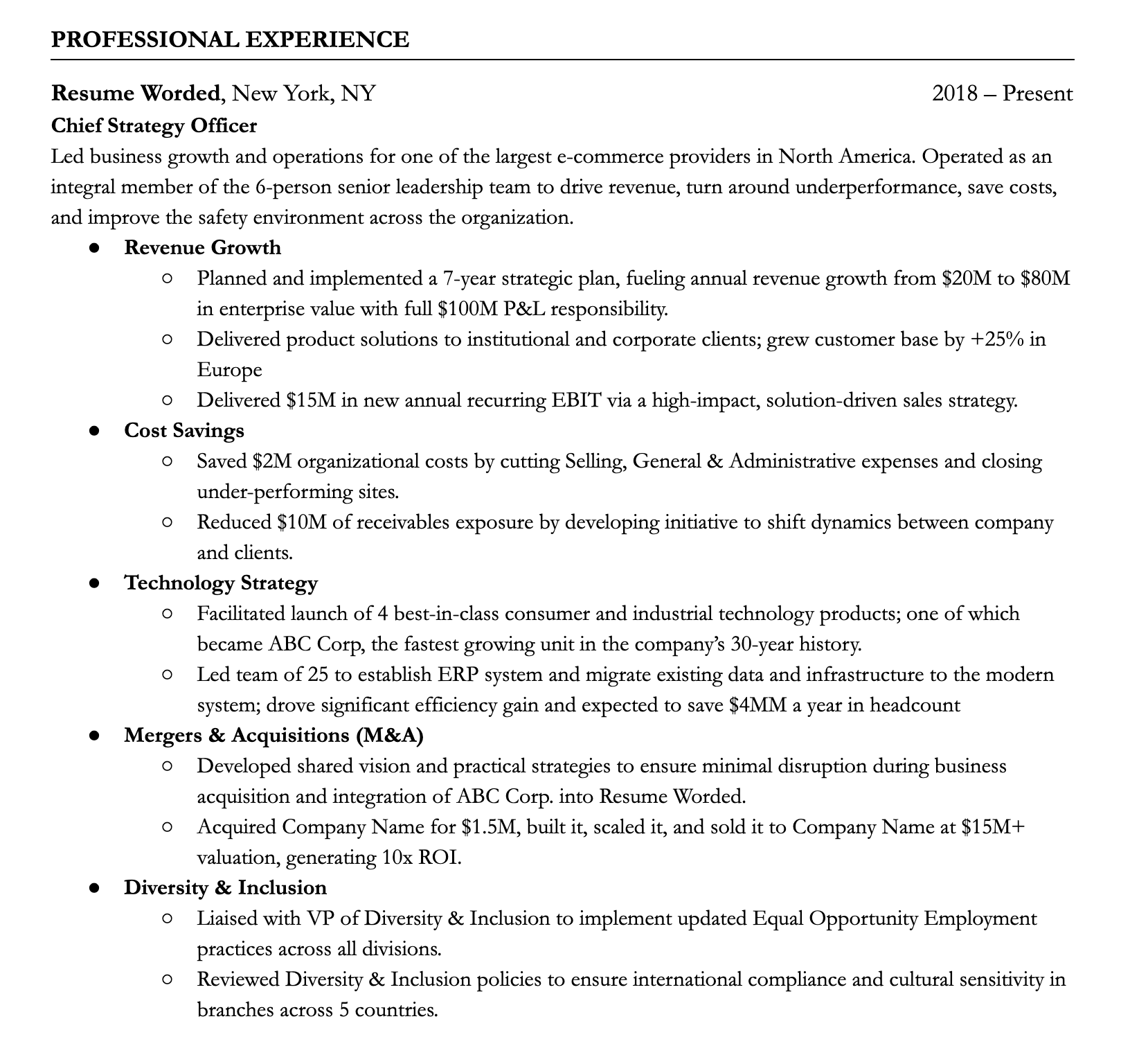
The more recent the role, the more detailed your accomplishments should be. Your most recent position might contain upward of 10-15 accomplishments split across different categories, while older roles might only have 1-2.
What to do about older positions
For any positions older than 10-15 years , either leave them off your resume entirely or condense them by listing only the company name, your role, and the dates.
Bullet points Here’s what you need to know about crafting high-impact resume accomplishments in your work experience section:
- Start with a strong action verb .
- Focus on accomplishments, not responsibilities.
- Include numbers and metrics to quantify your achievements .
- Be specific. Avoid vague buzzwords like “effective” or “various.”
- Lead with your most relevant accomplishments — don’t bury your strongest achievement at the bottom of the page.
Want to dive in? Read how to write a work experience for executives . You'll also learn how to write bullet points for an executive resume.
Resumes for experienced professionals don’t need a detailed education section. List any degrees in reverse chronological order (most recent first), including the name of the school you attended, the degree(s) you attained, and your major. You can omit any extra information, like graduation dates, coursework, and GPA.
You can list your hard skills in a relatively short section at the end of your resume. Stick to high-level leadership skills and core industry-specific competencies.
Your skills section is essential to getting past Applicant Tracking systems, which will automatically scan and weed out resumes without essential keywords — for example, the word “financial” in a CFO resume. Here are some of the key skills executive recruiters are looking for:
- Business Development
- Change Management
- Diversity & Inclusion
- Revenue Generation
- Profit & Loss Management
- Mergers & Acquisitions
- Stakeholder Relations
- Cultural Leadership
- Contract Negotiation
- Fiscal Accountability
To make a big impact in a small amount of space, use subheadings for specific skills and stick to 3-4 categories that are more relevant to the role you’re applying for.
Ready to get started? Read how to include essential skills for executive resumes .
Optional sections
Because executive resumes should mainly focus on your work experience and core competencies, you don’t need to dedicate a lot of space to additional information. That said, it can still be a good idea to include one or two optional sections toward the end of your resume, especially if you can point to activities that are highly regarded or add leadership experience. These might include:
Board memberships. Sitting on a board of directors can add prestige and credibility to your resume, especially if you were involved with a prominent organization or one related to your current field. List the name of the organization, your role, and the dates you served.
Professional affiliations. Similarly, membership in a well-known professional association — especially if you were heavily involved or in a leadership role — can deserve a place on your resume. List the name of the association and whether your membership is current.
Certifications. Only list these if they’re relevant to your current role. If you hold a qualification that’s highly recognizable or essential in your industry, consider highlighting it in your executive summary as well.
Volunteering. In most cases, volunteering doesn’t fit on an executive resume. However, other types of community involvement can go at the bottom of your resume. In particular, highlight leadership roles and other industry-relevant activities.
Key tips for executives
If you’re updating an existing resume rather than writing one from scratch, here are some key things to keep in mind.
Executive resumes look different
Struggling to showcase your leadership potential while keeping your resume under one page? There’s a reason for that. Executive resumes are typically longer two-page documents featuring additional sections and a more extensive work history. Here’s how to update your mid-level resume to an executive resume format:
- Split your work experience into subheadings reflecting core competencies.
- Include more bullet points for your current or most recent role.
- Leave off jobs older than 10-15 years.
- Include additional sections as relevant — for example, board memberships , professional affiliations , certifications, and community involvement.
Stress leadership and management experience
Executive roles require leadership above all else, so make that the focus of your resume. Here are some quick tips:
Use keywords in your resume title and headline. Your resume title should reflect the title of the job you’re applying for, while your headline can contain core competencies or similar roles you’ve held in the past.
Focus on management experience in your summary and bullet points. Choose accomplishments that show leadership and related skills , and put your most relevant achievements at the top of your resume. If a recruiter only spends a few seconds skimming your resume, they should still walk away with the sense that you’re a potential fit.
A good way to check if you’ve chosen the right accomplishments that show leadership and related skills, is to upload your resume to the tool below — it’ll tell you if your resume summary and bullet points show enough of the management skills that hiring managers and recruiters look for.
Choose skills that speak to your leadership ability. Your skills section is a small but powerful part of your resume, so make every word count.
If you’re unsure what skills to add to your skills section, search for the job using the tool below. It’ll give you a list of skills relevant to the job. For example, search for a job like Chief Financial Officer, or other executive positions and it’ll give you a list of skills required for the role.
Size matters
When it comes to leadership roles, the scope of your experience is as important as the details. That’s not to say that you can land a C-level position at a Fortune 500 company if you’ve only ever helmed 10-person startups, but either way, make sure you start your resume by explaining the context of your work experience.
Emphasize promotions
You may be near the top of your field now, but recruiters will want to know how you got there. Here’s how to emphasize that you worked your way to the top:
- Show progression in your job titles. Bold titles that show obvious progression, like Vice President -> Director -> Managing Director .
- Use leadership-centric language that shows increased responsibility, like “ Led ,” “ Drove ,” and “ Spearheaded .”
- Use bullet points to highlight promotions . If you were promoted ahead of schedule, say so.
Use metrics
Hiring managers want to see the impact of your accomplishments on a company’s bottom line. Here are some good metrics to use in your resume:
- Company or team size
- Number of locations
- Revenue generated
- Managed budget
- Money saved
- Increased throughput
- Project complexity, scale and duration
Always use concrete numbers when you can. These don’t need to be exact — a reasonable estimate is fine.
Spread the word
Expert tips: how to showcase your areas of expertise on a resume, essential skills for executive resumes, keep reading, how to show bilingualism on your resume (with examples), oops what to do if there’s a mistake on your resume, getting the basics right: resume line spacing, subscribe to our newsletter.
Stay updated with Resume Worded by signing up for our newsletter.
🎉 Awesome! Now check your inbox and click the link to confirm your subscription.
Please enter a valid email address
Oops! There was an error sending the email, please try later

Thank you for the checklist! I realized I was making so many mistakes on my resume that I've now fixed. I'm much more confident in my resume now.


How to Write a Compelling Executive Resume [with Examples]

Expert Tips for Executive Resume Content and Formatting
If you're making over six figures as an executive or senior manager, you're playing in the big leagues when it comes to recruitment.
For senior executives, the stakes are high.
Because your resume is often a recruiter's first impression, you need to make sure that it nothing short of perfect.
The risk of missing out on a potential opportunity because you failed to clearly articulate your accomplishments or fully convey the value you bring to an organization simply isn’t worth it.
Our executive resume writers have crafted effective documents for CEOs, Managing Directors, and Senior Directors in industries including real estate, finance, pharmaceuticals, and technology.
In this post, we share our insights on:
- How our writers approach resumes for senior leaders
- How long an executive resume should be
- How to write and format your resume for maximum impact
- How to optimize your resume for ATS
How Our Executive Resume Writers Approach Resumes for Senior Leaders
Executive resume content differs slightly from that of more junior resumes.
When working a senior candidate, our writers ensure that the resume’s focus is primarily on high-level accomplishments and contributions you made to an organization - not simply daily responsibilities.
While the bullet points on junior candidate's resume will likely describe day-to-day tasks and the types of analyses the candidate conducted, we make sure to convey the bigger picture.
A well-written executive resume should highlight tangible factors such as the following:
- Scope of work (number of locations managed, project value, P&L value)
- Relevant financial metrics (budgets managed, costs and/or time saved, revenue increased)
- Strategic goals accomplished
- Initiatives led or implemented
- Team leadership ability and size of team
- Partnerships created
- Sales achieved or deals closed
How Long an Executive Resume Should Be
Our general guidance when it comes to resume length is that less is more .
In our opinion, even the President of the United States should be able to put together a strong one-page document.
If you are in a senior leadership position, however, you may realistically need two pages to effectively convey your accomplishments.
Your overarching goal should be to create a resume that is as concise as possible, neatly formatted, and easy to read.
Think of your resume as a movie preview.
It should be a 30-second clip of what the reader can expect to learn more about when they meet you during the hour-long interview.
Each bullet point needs to add value, and you should not have any "fluff" that inflates or excessively boasts about your accomplishments.
Let your experience speak for itself.
If you hold a senior position, your career growth already demonstrates that you are a "strong team leader" and "ambitious, driven professional."
You don’t need to put such generic, empty phrases down on paper.
In addition to serving as a personal marketing tool, your resume provides a sample of your business writing and communication skills.
As an executive, you need to demonstrate that you are a clear, concise, and effective communicator - not simply a big talker.
How to Write and Format Your Resume for Maximum Impact
In this section, we explain how our writers approach each resume component.
We also included screenshots from executive resume samples to demonstrate the best practices discussed so you can implement them in your document.
Your heading should include your name, any professional designations, and contact information.
You can also include the link to your LinkedIn profile.

Professional Summary
We don’t recommend a career highlights or professional summary section for junior candidates.
For executives, we sometimes use a career highlights section to provide concrete evidence of achievements and career progression.
Professional summaries that consist of generic buzzwords don’t sound believable without any evidence to back up their statements, so make sure that yours incorporates concrete facts and examples.
We typically try to stick to a maximum of 4-6 bullet points, as they're easier to skim than longer paragraphs.
We wrote the following career highlights section for a candidate working in the financial services sector:

The summary above is effective because it accomplishes the following goals:
- Demonstrates career progression
- Describes major accomplishments
- Articulates niche or sector expertise
- Quantifies the value contributed and scope of responsibility
- Provides evidence of leadership ability (internal and external)
Professional Experience
When describing each role in the professional experience section, we make sure to focus on achievement-based elements such as:
- Strategic goals and their implementation
- Financial results
- Partnerships forged
- Revenue generation
- Leadership ability
You can also consider including more general responsibilities in paragraph format before jumping into bullet points that convey your key achievements and contributions.
Take a look at the following example from a resume for a Vice President in the online learning sector.

By separating day-to-day tasks from achievements, we are able to:
- Draw attention to the highlights: We make sure that recruiters can easily pick out major accomplishments. You don’t want to bury yours among less impressive - albeit important - information.
- Organize the resume: Separating your responsibilities from your achievements is a clear, logical way to structure your document, demonstrating that you have effective business communication skills.
Early Career
The bulk of your resume’s content should focus on your most recent positions.
Because it is still important to provide an overview of your career progression and background, we usually include positions that candidates held over 10 years ago in an early career section.
For brevity's sake, we only include company names, position titles, and dates for these roles.
By including an outline of your early career history, you are able to:
- Demonstrate the breadth and depth of your experience if you worked in different industries and positions
- Increase your credibility
- Refrain from overwhelming recruiters with too much information (if they’re curious about an earlier role, they’ll ask)
In this section, include all of the degrees you earned from post-secondary institutions.

Unless you recently completed your program, you don’t need to include elements such as:
- Relevant courses
- Extracurricular involvement
Certifications and Professional Development
If you completed any certificate programs or professional development courses, list them separately from your education.

You should always include:
- Granting organization
- Certification name
- Date earned
- Expiration date (if applicable)
Board Involvement
List board or committee service that are relevant to your target positions under a "Board Membership" or "Board Involvement" heading.
The section below, taken from a commercial real estate resume sample, demonstrates the candidate’s involvement in helping a smaller firm and non-profit organization expand:

This section can enhance your document by demonstrating your skills or industry knowledge that go beyond your sector of expertise.
It's also a reflection of your leadership ability and shows that you are respected in your industry or community.
For each position, include:
- Name of the organization
- Dates of service
- Position title (Chairman of the Board, President, Board Member)
- Description of the capacity in which you are involved (if significant and you have room)
If you hold multiple board memberships, you may wish to only highlight or only elaborate upon the most relevant ones - especially if your document is on the longer end.
How to Optimize Your Resume for Applicant Tracking Systems (ATS)
Because so much of executive-level recruiting takes place through recruiters or industry connections, ATS optimization isn't as much of a concern as it would be for more junior candidates.
However, it is still best practice to optimize your resume for ATS.
Even when working on executive resumes, we make sure to thoroughly read through the job description and naturally incorporate relevant keywords throughout our clients' documents.
By doing so, we are able to accomplish two goals:
- Optimize the resume for ATS
- Ensure that we are touching upon the qualities and skills recruiters will be looking for
In executive recruiting, connections and industry expertise are essential to landing new roles.
However, the way you present yourself on paper reflects on your personal brand, attention to detail, and overall professionalism.
Put your best foot forward by implementing the steps above and avoid gimmicks that can damage your credibility , and you’ll be one step closer to your next big career move.
About Resume Pilots
Resume Pilots is an award-winning executive resume writing firm and a proud member of the Professional Association of Resume Writers and Career Coaches. Our previous clients include CEOs and senior executives at the world's leading companies.
As a professional services firm, we take your reputation seriously. We are committed to delivering writing excellence and superior service while operating with integrity and discretion. Recruitment firms we partner with also trust us to consistently deliver quality documents for their clients.
Our writers have studied in the Ivy League and other top-tier universities and have strong writing backgrounds coupled with industry experience.
Here's how we can help you:
Resume, Cover Letter, and LinkedIn Writing Services : If you are looking for end-to-end support, hire one of our professional resume writers to rewrite your documents from the ground up.
Executive Resume Template Downloads : If you plan to prepare your own resume, consider using one of our classic, ATS-friendly resume templates for Microsoft Word.
To learn more about our services, book an introductory call with our founder here or email [email protected] .
- Share on Facebook
- Share on Twitter
- Share on Google
- Share on Pinterest

About the Author Matt Glodz
Matt Glodz is the Founder and Managing Partner of Resume Pilots and a Certified Professional Resume Writer. After studying business communication at Cornell University, Matt worked within Fortune 500 companies, where he noted that qualified candidates were frequently denied interview opportunities due to poorly written documents. At Resume Pilots, Matt combines his business and writing background - which includes prior work for a Chicago Tribune publication - to craft resumes that give his clients the best chance of landing interviews. He works with clients ranging from CEOs to recent graduates and has been writing resumes for over 10 years. He has been quoted on numerous business and career-related topics in outlets including Business Insider, CNBC, Fortune, Glassdoor, The Ladders, and Thrive Global.
Related Articles
Should you include a professional summary on your resume, how to write a strong linkedin summary, when should i remove internships from my resume.
- • Developed and executed strategic communication plans for 10+ major tech clients, resulting in a 30% increase in brand visibility.
- • Managed a team of 15+ account executives, fostering a collaborative environment that boosted team productivity by 40%.
- • Secured media coverage in top-tier technology and business outlets, increasing client exposure by 50%.
- • Managed 8+ key tech accounts, leading to a 25% increase in client retention.
- • Coordinated with cross-functional teams to execute strategic plans, resulting in a 35% increase in project success rate.
- • Secured speaking opportunities for clients at major industry events, boosting brand recognition by 30%.
- • Handled 5+ major tech accounts, leading to a 20% increase in client satisfaction.
- • Worked closely with teams to execute strategic plans, boosting project success rate by 30%.
- • Secured media coverage for clients in top-tier outlets, increasing brand visibility by 40%.
17 Executive Resume Examples & Guide for 2024
Customize this resume with ease using our seamless online resume builder.
All resume examples in this guide

Alliance Manager
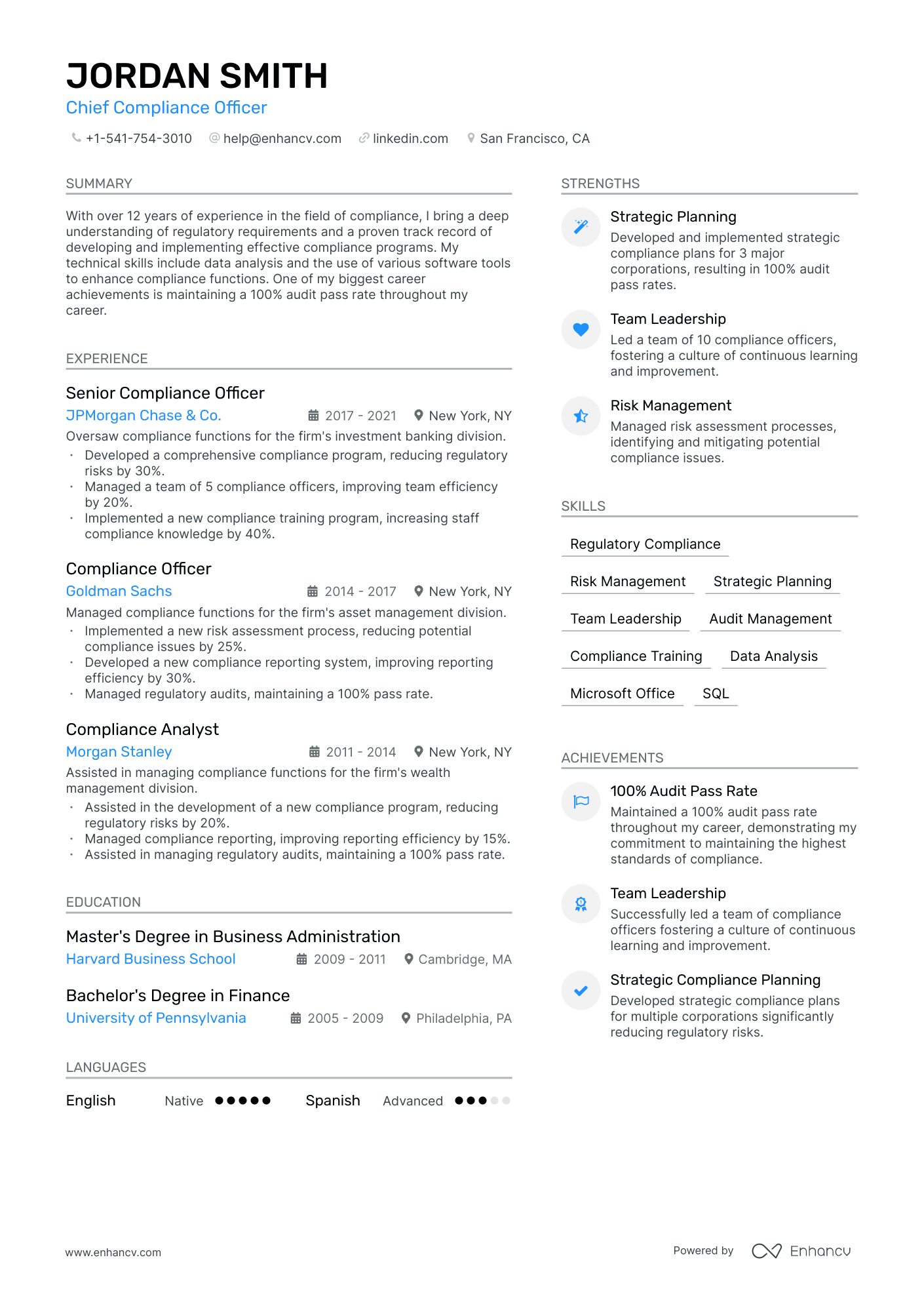
Chief Executive Officer

Chief Financial Officer

Chief of Staff
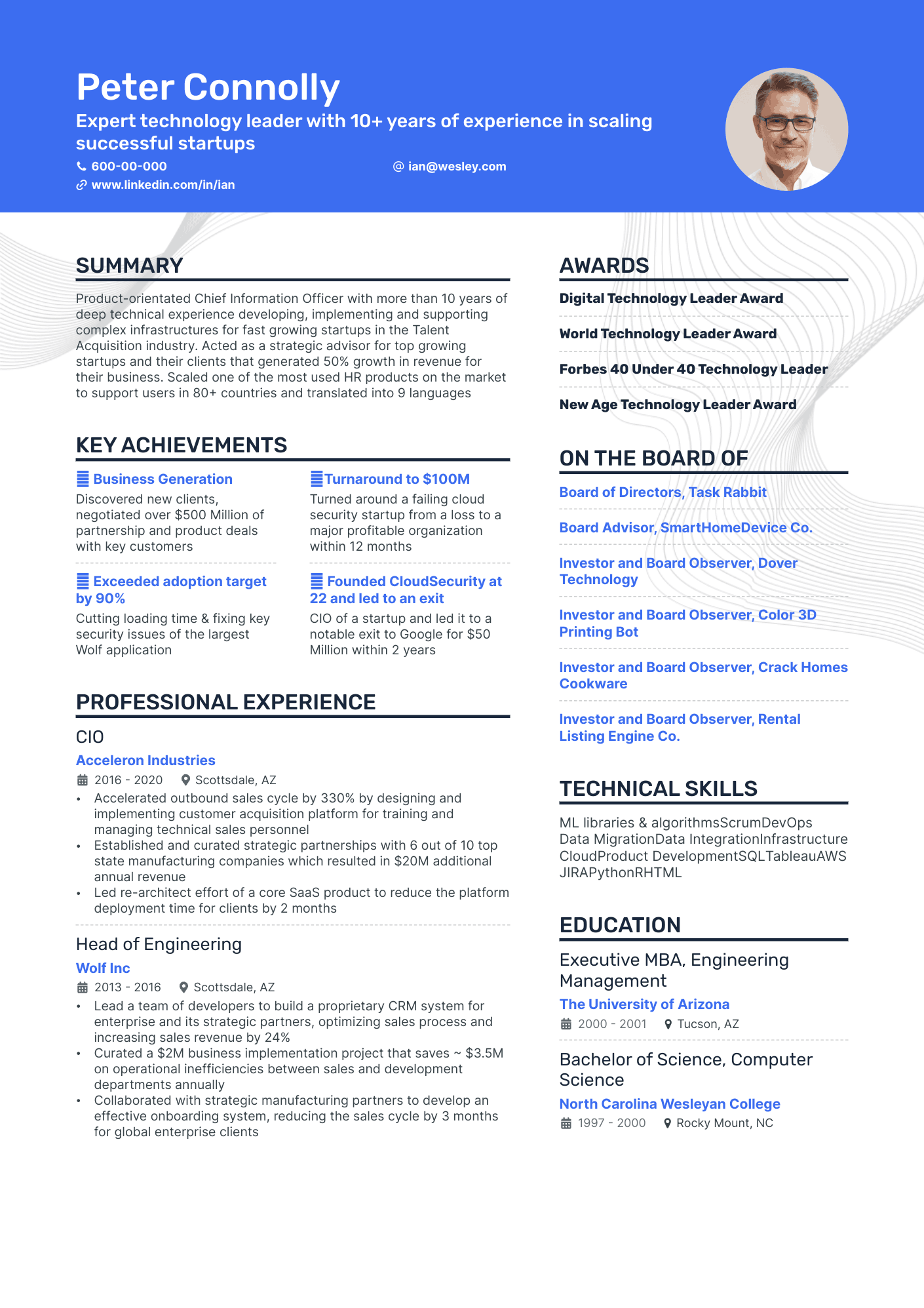
Department Head
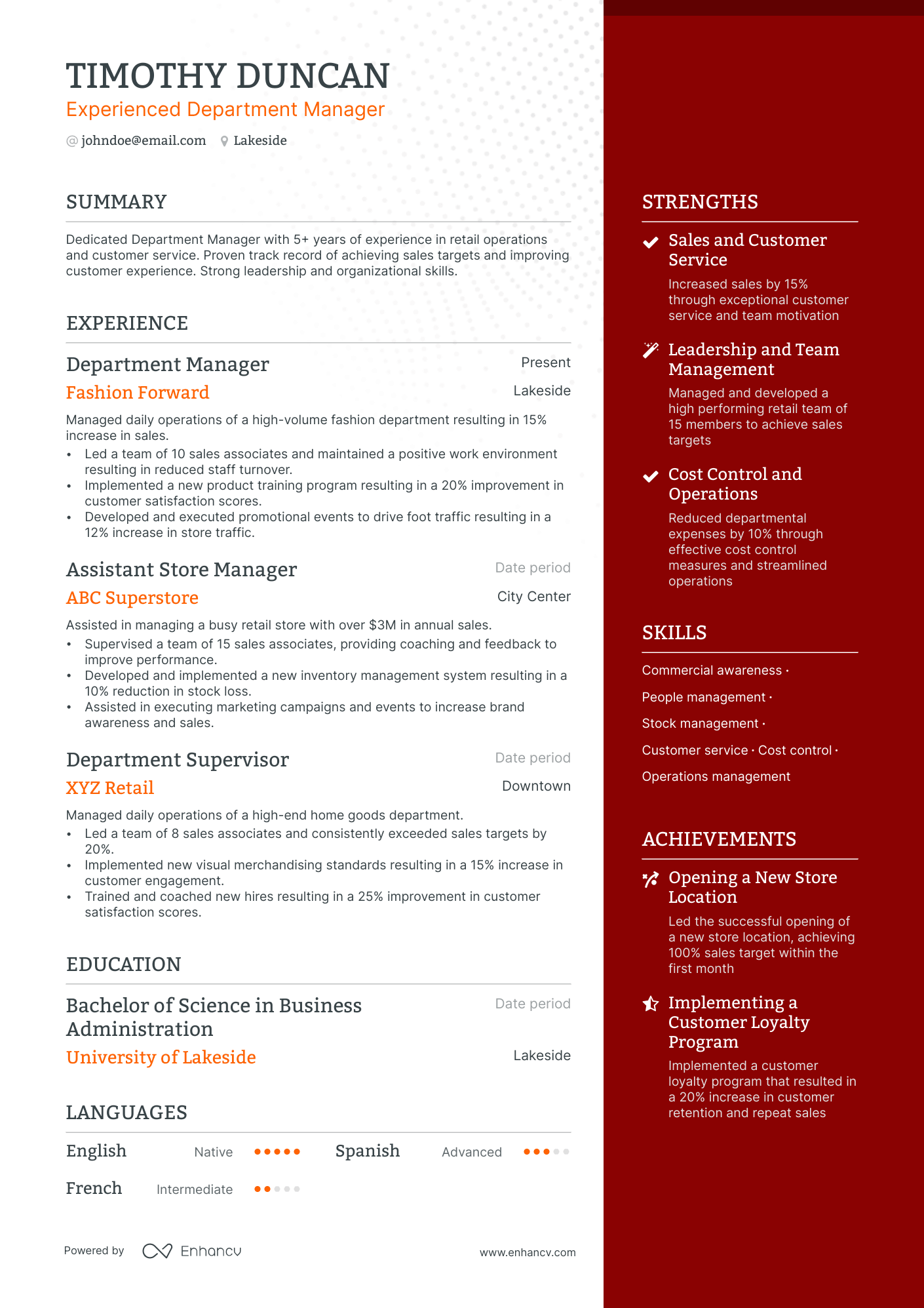
Department Manager

Executive Director
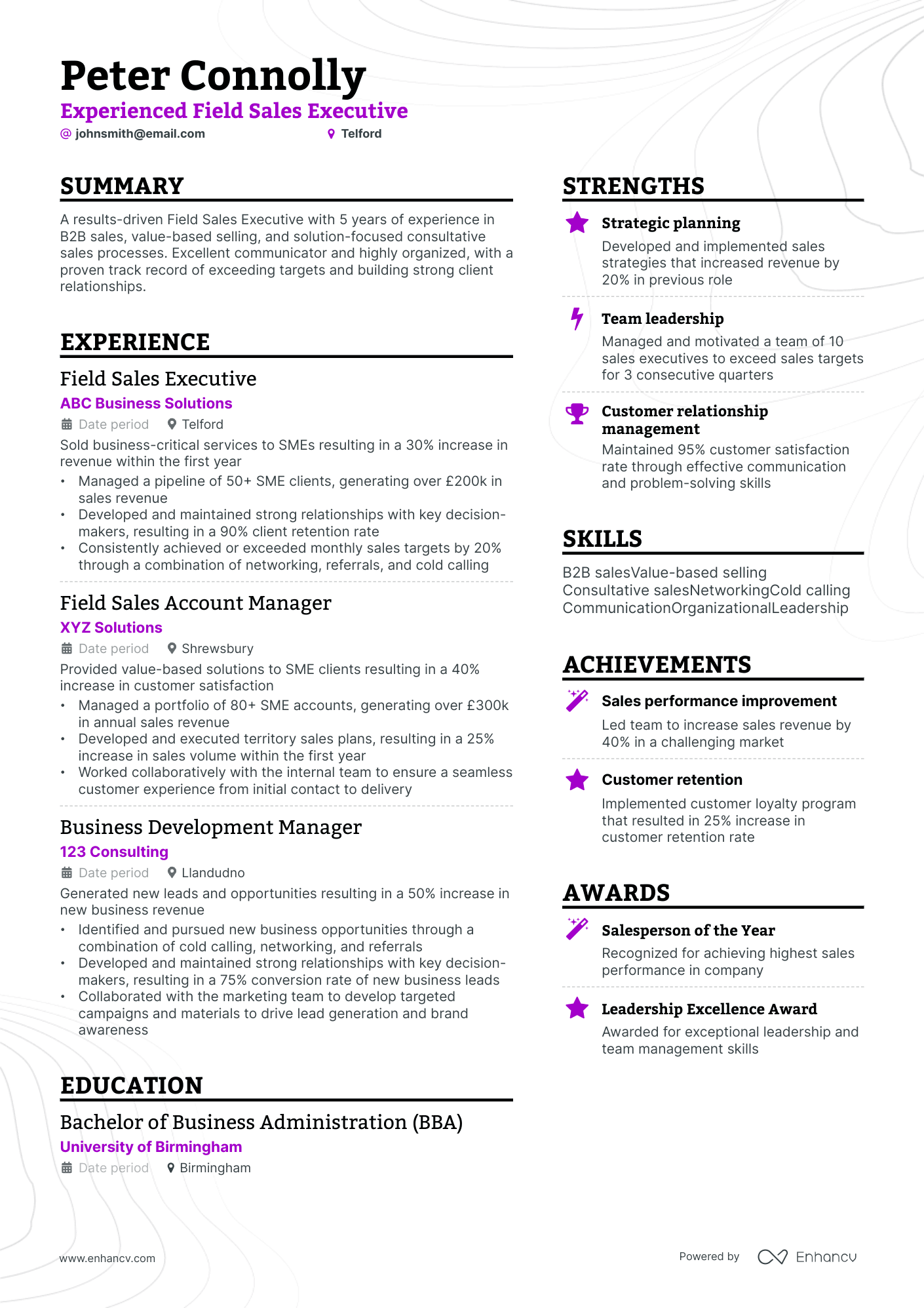
Executive Manager
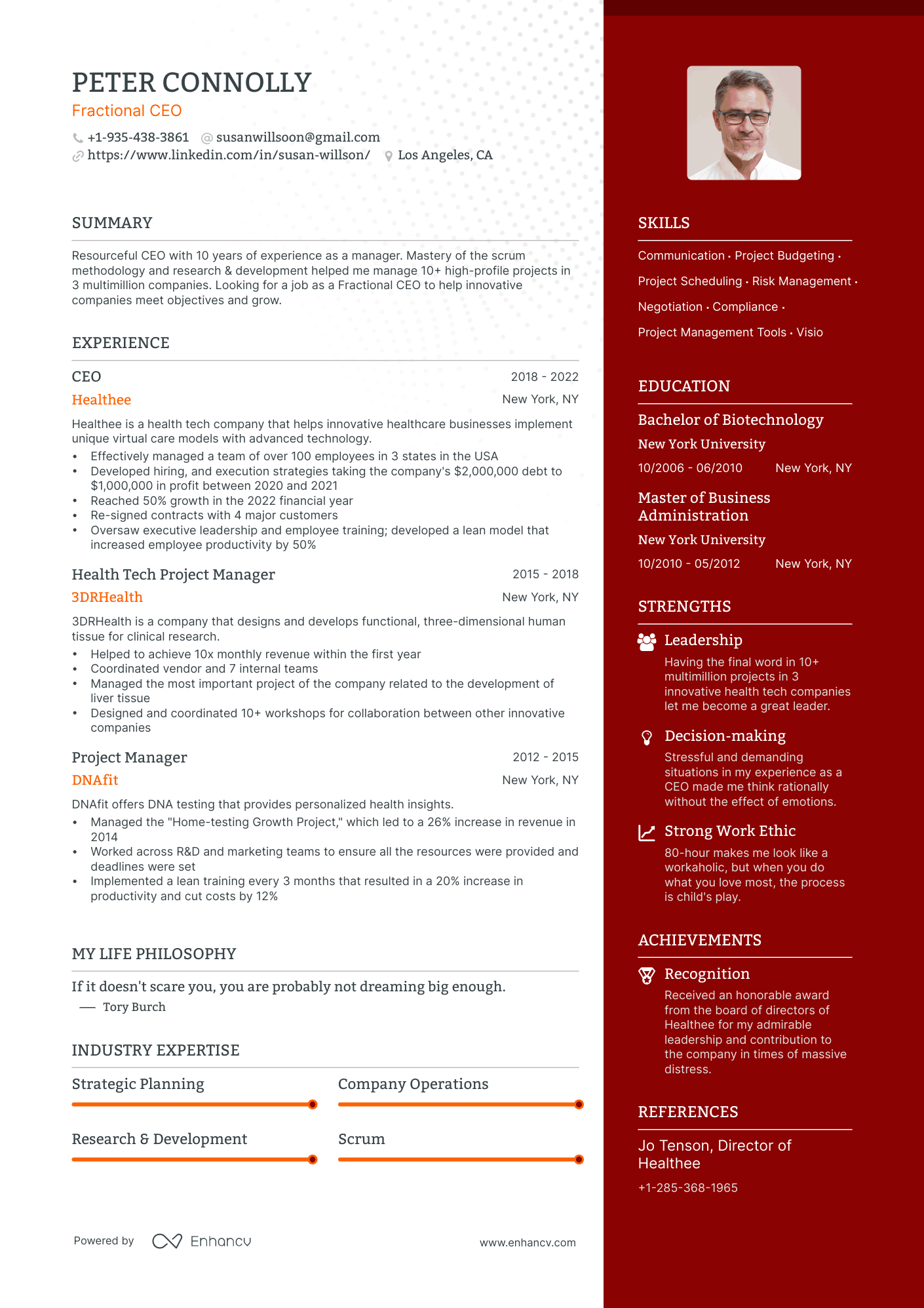
Fractional CEO
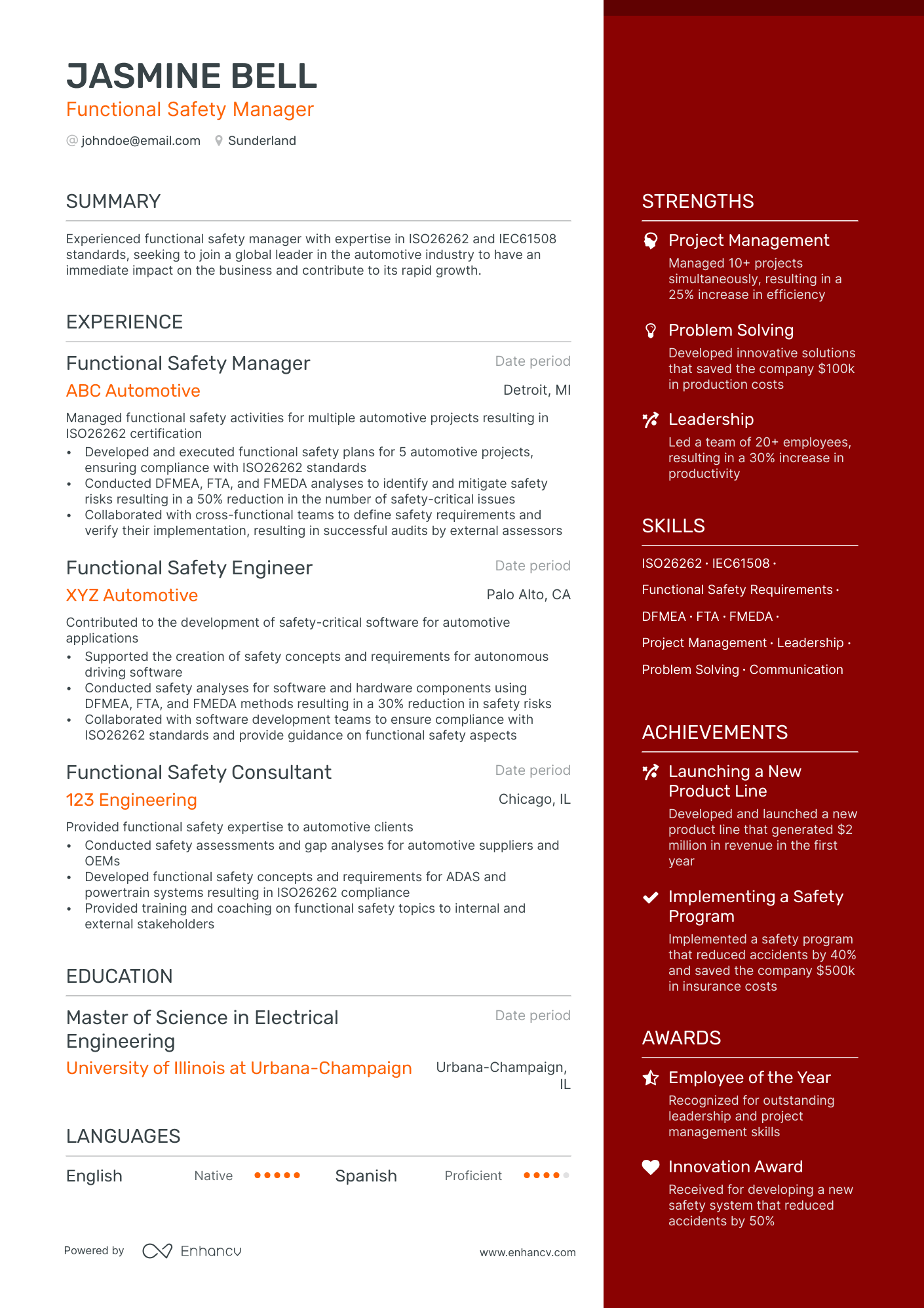
Functional Manager
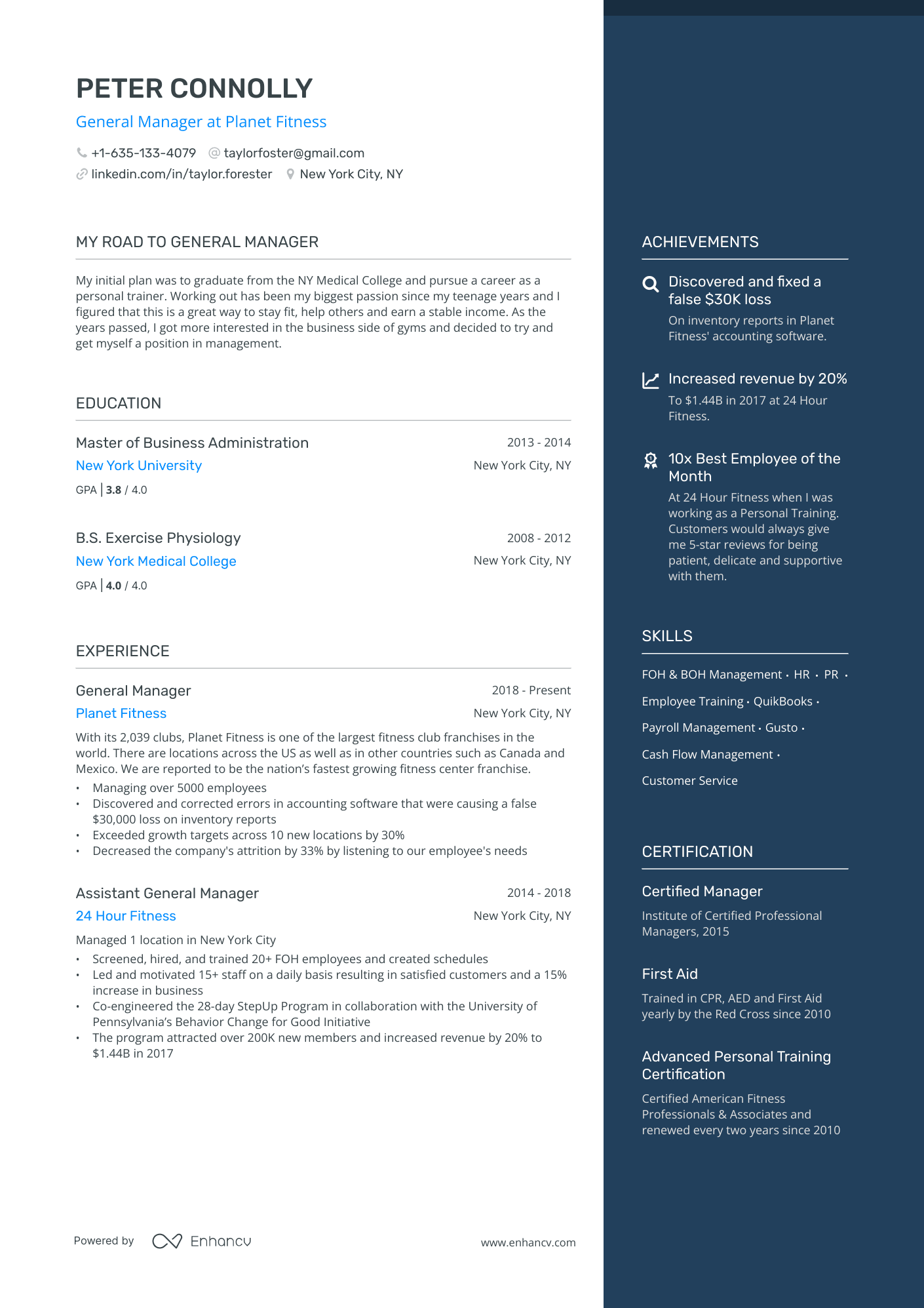
Vice President

Board of Directors
Resume guide, this guide will show you:, looking for a specific c-level resume, how to write an executive resume to land more interviews, resume header: make sure recruiters keep reading, resume summary: instantly stand out at every stage, resume experience section: maximum efficiency word for word, c-level skill section: what recruiters really like to see here, resume education section: do you need it, resume certificates: which ones are the best, how to write a senior executive resume, do you need to hire a professional resume writer, additional sections to boost your resume special sauce, key takeaways:.

So you want an Executive resume that sets you apart.
But things changed in a big way. All the talk now is about these robo-scanning systems that won't even register resumes that don't fit their obscure guidelines.
And once you submit your executive resume, it will be reviewed by an army of recruiters who are relentlessly looking for the right combination of skill, achievement, and experience.
The next person it gets forwarded to is a member of a search committee who won’t bother reviewing it twice.
Somehow your Executive resume has to work on all three levels.
Bad news is that it's tough. Good news is that it’s possible.
- Executive resume example that gets high-profile interviews 9 out of 10 times.
- What specific things recruiters want to see in your Executive resume and how to use that to your advantage
- How to convey your excellent leadership and visionary skills on a piece of paper (i.e. how to make your resume speak)
- How to make sure your Executive resume stands out while passing automated resume scanning systems in 2021
- Marissa Mayer Resume
- VP of Sales Resume
- VP of Business Development Resume
- VP of Marketing Resume
Writing an executive resume doesn’t follow your typical resume writing process.
Your Executive resume should not be about simply listing previous jobs and skills — companies are looking beyond that in their future executives.
You are their next leader, and your Executive resume should achieve at least three key objectives:
Demonstrate tangible impact. Bragging with years of experience as a C-level manager won’t impress anyone. Your resume should demonstrate the real impact of your work, as recruiters won’t be looking for someone who simply adjusts to their environment. They’re looking for someone who can lead and change things for the better. Bad example: Managed a team of 30 engineers. Good example: Coordinated the work of more than 30 engineers in the development, testing, and production phases of a $10M project in the aero composite niche. More examples and tips in the Experience section. Hint: use resume action verbs to captivate recruiters and form the best first impression.
Convey a strong personal brand with unique differentiators. Your resume is not just a marketing tool — it's a storytelling device. If you want to increase the chances of landing a job tenfold, align your personal story with the company's brand. Executives are too often a part of their company’s brand.
Are you tech-savvy genius with exceptional instincts for trends? A roll-up-the-sleeves guy on the frontline? Make sure your personal brand aligns well with the company brand.
Here’s how to establish a career-winning personal brand in your Executive resume:
- Identify key accomplishments and skill scenarios in the top-third of your resume
- Include industry-unique resume keywords to build relevance and authority
- Differentiate yourself from other candidates by showing off your unique differentiators.
More details on how to do that in later sections. Provide consistent excellence throughout the entire recruitment process. The process of hiring someone for an executive role involves multiple interviews and stages.At every stage your executive resume will be read by several people for the first time. That means your resume should not be a one-time wonder — it has to consistently WIN on every level: during automated ATS resume scans , manual checks by a hiring manager, and elaborate analysis by C-suite stakeholders.
Here’s how to turn your Executive resume into a golden ticket on every stage:
- Format, format, format. With a clever use of white space, layout, color , font , bold text, and headers, you can make your resume extremely attractive for both humans and robots.
- Use snippets of your resume to enhance your social profiles. Create consistency across various recruitment channels (LinkedIn, personal website, professional profile) to become memorable and project a consistent message.
- Don’t fall for a one-page resume myth . Entry-level candidates should have a one-page resume. Tech professionals can have a one-page resume. But executives with 15+ and 20+ years of excellence, industry awards, authority publications, and hard-won leadership skills? No.Even though we are strong advocates of the “more with less” approach, you won’t benefit from cutting out your best resume bits simply because you heard that one-page resume is good for someone.
The executive resume guide helps you write one that gets approved by both robotic ATS systems and human recruiters . We'll examine key areas of your resume to make sure it stands out and aligns with the company you're applying for.
Here are the sections that your Executive resume will include:
The 6 Most Important Sections of Your Resume
- A properly formatted
- A concise and impactful
- A tailored to the specific job
- Custom sections
- Education & Certificates sections
What recruiters want to see in your resume
- Are you a good leader with all the necessary skills for the job?
- Is your position consistent and strong throughout your whole resume?
- Are you a good fit not only in the short-term perspective, but also for the years to come?
- Do you have a solid personal brand and how well does it align with the company’s?
- Can you make an impact, and is there any evidence that you're capable of leading for success?
Your Executive resume starts with a Header. Let’s make sure it’s properly formatted and doesn't turn recruiters away.
We’ll start with the obvious: there are many executive roles in a company.
You have CEO (chief executive officer), COO (chief operating officers), CTO (chief technical officer), CIO, CISO, CSO, and the list goes on.
And yes, there’s a lot of overlapping responsibilities between these jobs. A CIO in one company sometimes can transition to COO/CTO in another.
Despite that, it’s extremely important to use the same title in Header that the job you’re applying for uses, because COO and CIO in the same company do absolutely different things.
You must avoid using more than one title, even if you were working under both titles at one point in your career. This sends mixed signals to recruiters.
It goes without saying that your Header should include your contact details, but many applicants only give their phone number and email address.
Today almost every recruiter checks your LinkedIn profile along with your resume. Include the link to your profile in a header to control the narrative. A well-crafted LinkedIn profile with many connections makes you appear more credible and trustworthy. Check your executive resume and LinkedIn profile to make sure the work history is cohesive. Also, enhance your LinkedIn profile with some bits from your resume to ensure consistency.
If you don't have a developed LinkedIn profile, don’t link to an empty one. It’s better to link to your personal portfolio website or active membership profile in an authoritative, industry-specific network.
Point is, the link should work for you, not against you. But we strongly recommend to start working on your LinkedIn profile ASAP.
Here’s an example of a header that doesn’t work well:
2 executive resume header examples
Here we’ll include link to a Linkedin social profile, as well as use only one title that the job description mentions:
Check out our guide on perfecting your resume header with industry-leading examples !
Now let's engage recruiters even further with an impactful Summary section.
The Summary section can have an incredibly powerful effect on your resume, but it works both ways.
If your Summary section is short, engaging, and relevant to the position, it will engage recruiters and create a lasting positive effect on how they perceive the rest of your resume. Think of the Halo effect.
If your Summary section is long, tedious, and full of fluff, recruiters might not even bother reading further. A major benefit of the Summary section is that you can easily adjust it to every position that you’re applying for once you get the basics of writing it.
Here are some tips to make your Executive Summary section stand out and create a good momentum with recruiters:
- Keep it short. Two or three sentences should be enough to grab someone’s attention. If you’re going beyond that, either rephrase or use other sections to provide more details, e.g. Achievements or Experience sections.
- Keep it relevant . This is going to be recurring advice, but learn as much as possible about the company you’re applying for before writing a resume. What are their values? Are they growing? Are they in crisis?Summary is the first section where your research pays off. If you think the company needs a crisis manager, mention how you were able to transform a struggling business.If the company is a promising startup or a rapidly expanding network, make sure to mention your experience of scaling businesses and navigating a fluid business environment. Mention industry-specific experience relevant to the job to get some bonus points.
- Keep it impactful. Don’t simply brag about your qualities. Provide results and achievements. Instead of writing how you spent 10 years in marketing or corporate leadership, share what the company was able to achieve with your guidance.
Here’s an example of a tedious, self-centered Summary section that makes employers and hiring managers roll their eyes:
2 executive resume summary examples
And here is an example of an engaging summary section to persuade readers to read further:
If you’re applying for another executive position, for example Chief Marketing Officer, follow the aforementioned advice but adjust it to the exact responsibilities of your future role.
Below is an example:
Want to learn more about crafting unique and engaging Summary sections? Check out our Perfect Summary guide with 30+ industry-specific examples .
We’ll now move forward to the bread-and-butter of your Executive resume, the Experience section.
The Experience section is the most elaborate and extensive section of your Executive resume, and recruiters will be returning to it several times throughout the whole recruitment process.
At first they’ll skim through it to understand whether you have a relevant experience, and leadership skills. This is where the most candidates will be filtered out.
During the next phase they will check whether your resume contains specific results and workflows that led you to achieving those results. They’ll be asking themselves: is this someone we need right now?
During the final round of checks, they’ll be comparing it with other candidates and see if you’re a good fit not only in the short perspective, but for years to come.
It doesn’t help that the Experience section is one of the hardest to write because executives have to squeeze in decades of experience in just one page, and make sure there’s still a place left for other impactful sections.
Let’s talk about what you need to include in your Experience section to get more calls, and what better should be left out of it.
Everything you mention in your Executive resume experience section falls into three main categories:
- Buzzwords (resume keywords)
Results are the most impactful component of your experience section. Your achievements should be quantified, otherwise it’s just a string of words. Use numbers for more impact. Bad example: increased company’s presence on the education CRM market
Good example: over 3 years grew revenue in educational and mortgage segments by 300%
It’s important what kind of results you prioritise. Carefully study job requirements to understand what are the current company goals. Is it cost-efficiency? Workplace innovation? Or a new product launch? Prioritise results that are more relevant.
Workflows are what you did to achieve the results, or circumstances. Those are a perfect opportunity to hint at your core qualifications.
Workflows will reveal your subject matter experience, leadership and strategic qualities, and core competence in driving financial and operational results. You should describe workflows as challenges that you overcome. Use these questions to help to uncover some gems:
How did you contribute to the success of a company in a way that others didn't or wouldn't? What did you do that made the company better, more profitable, more efficient, and more competitive? How did your work benefit your coworkers and clients? What ideas of yours changed the course of events? Again, carefully study job requirements to understand which workflows will play a bigger role. No two companies are the same, so executives’ responsibilities will vary based on the company's size, industry, structure, and culture.
Buzzwords, or resume keywords, are largely defined by trends in every industry, and you can use them to quickly bring your resume up to date and target companies that are looking for very specific competencies.
Examples of buzzwords per industry: distance learning in education, crisis management in travel industry, managing distributed teams in real estate, machine learning and agile practices in IT, and so on.
Don’t overuse trendy words though, and especially don’t insert them blindly just to impress executive recruiters. Use only those skills that you have hands-on experience with.
Again, study job requirements to understand what kind of buzzwords may play into your hands.
For the best results, combine results, workflows, and buzzwords. Study job description and put more relevant workflows on top.
Here’s an example of vague experience section which is more focused on circumstances of work rather than results:
Executive resume experience examples
- • Established and built relationships with top leaders in the market
- • Directed and oversaw financial and budgetary activities
- • Direct the company in keeping with the vision outlined for the company by the Board of Directors
Here’s an experience section optimized for impact with relevant results and comprehensive workflows:
- • Established and built relationships with top leaders in the market, including those representing the highest levels in business, government and non-profit sectors, growing export revenue by 300%
- • Ensured coordination and alignment of all company activities to strategic direction in the areas of resource development and staff alignment, reducing department costs by 25% two years consecutively
- • Planned, organized, directed, and evaluated labor and administrative policies and operations that brought company from state leaders to country leaders.
Here’s an example of how the Experience section might look if you’re applying for a CTO position.
Notice that it contains more buzzwords and technical terms that were revealed after studying the company background and its key products:
- • Established, communicated, and developed a clear action plan for the new vision of Technology Department, reducing $4M annually on operating expenses
- • Facilitated in planning and release of 4 strategic company products that led to 23% increased ML-based CRM solutions market share
- • Increased client satisfaction on a company-wide level by 400% after implementing a set of advanced real-time reporting system for monitoring support staff performance
Beware of “death by bullets”, or using more than five bullet points in a row when describing your experience, otherwise your resume becomes unreadable. If you have too many bullet points, consider rewriting the section or adding short paragraphs of text in between.
Every executive role involves a wide range of skills. Add to that 15 years of experience on average and every executive can easily fill up a blank page simply listing all the skills they possess.
Don’t fall into this trap. No one will be reading that much. And the impact behind every skill will be diminished by the sheer amount of them.
The best thing you every candidate for an executive role can do is to prioritise skills that are needed the most for a given job, and then group those skills into broader categories.
Bad example: high performance under stress, predictive planning, negotiation, monitoring, critical thinking, etc.
Replace with: Crisis Management: Preserved company’s market share and net profit during the outbreak while the average competitor lost 10-20% of their income.
After you narrow down the most important skill categories, make sure to put those into context, because this is the most convincing way to demonstrate that you really have them.
For most executive roles, apart from Chief Technology officer, soft skills are a priority, so list them first.
Here’s an example how to list soft skills on your Executive resume:
How to describe soft skills on your resume
Below are some skills that you can group in your Skill section:
Soft skills list for C-suite resumes
- Communication
- Strategic management
- Strategic partnerships
- Resource development
- Analytical approach
- Financial management
- Presentation skills
- Revenue Growth
- Coordination
- Active listening
- Time management
- Problem solving
- Strategic planning
- Innovative thinking
- Quality control
- Lean/Growth mindset
- Collaboration
- Risk management
- Process organization
- Policy development
The amount of technical skills you need to mention in your resume will largely depend on the specific role.
Chief innovation officer, chief technical officer and chief information officer are expected to be more tech savvy than other executive positions, so listing some key technical skills would be of help.
Same goes for any executive role in IT-related companies vs other industries.
But mostly try to focus on your management skills and achievements associated with them.
Below are some technical skills you might mention in your executive resume:
Hard / technical skills list for executive resumes
- Financial & Accounting Software
Although experience is deemed far more important than education history for any executive position, you’ll rarely find a job that doesn’t require at least a bachelor's degree.
Education requirements vary from job to job. Some companies require a Master's degree in business or related field.
If you don’t have a relevant degree it might be substituted with an advanced business training, such as MBA. Make sure to put it before other information on education in your resume.
Certificates aren’t a decisive factor for an Executive resume, but they can strengthen your overall profile.
Note that chief technology officer and chief operations officer will have a different portfolio of certificates, although there are general leadership certificates that any executive resume can benefit from.
Below are some examples:
Top 5 executive certificates for your resume
- Harvard Kennedy School Executive Certificates
- Harvard Business School Certificate of Management Excellence
- MIT Executive Certificate
- Cornell University Executive Leadership
- Michigan State University’s Business Leadership and Management
- Target your resume to the position. It’s imperative that you tailor your executive resume to the position and the company that hires you. Don’t just demonstrate that you have the needed skills. Use the Experience and Summary section to demonstrate that you overcame challenges similar to what they experience right now. Often companies switch leadership in time of crisis and uncertainty. Learn more about the target company’s recent challenges and use this information to build authority and relevance.
- Make the most impact with the top-third of your resume . Your senior executive resume is going to be long, but to make sure people will read all of it you need to give them a motivation. Use the top third section to present your key achievements and skills.
- Maximise the impact of your third page. There’s no need to describe all the jobs you had over the span of a 20 or 30+ year career. This will certainly eat all the pages on your senior executive resume. Instead, use the last page of your resume to showcase your unique identifiers and set yourself apart: list awards, publications you were featured in, research projects, and lifetime accomplishments.
Having problems packing all your years of experience in a resume? Check out our guide on Resume Length: How Long Should a Resume Be in 2021
High-quality executive resume writers services start with $1000, but even they often don’t guarantee the success of your application.
As there’s no real proof to the value of these services, the choice of hiring an executive resume writer is up to you.
Here are some things to keep in mind when hiring a professional resume writer or a company:
- Executive resume writer is a proxy. An executive resume writer can proofread your resume and make it easy-to-read, but only you know in detail all the hardships and successes you have had over the span of your career. And too often executive writing services include only a couple of discovery calls to learn about your key skills and goals. Sometimes it’s better to write a resume yourself and then hire a professional editor to proofread it paying extra price.
- Learn about their process. Your success depends on the skill of a particular writer, and even then there are too many variables that impact the results.If your executive resume writing services company doesn’t spend at least several days learning about you and your strengths, consider yourself playing roulette.
- You still need to perform an ATS check. Executive writing services don’t guarantee your success with ATS scanners as they usually represent another side in the hiring process. Use our free resume checker tool to see whether your resume will pass robotic scanners and safely get to the recruiter.
Your executive resume provides impact and demonstrates that you have all the necessary skills to be successful in your work.
It’s time to stand out of your competition and leave a lasting impression with custom sections.
Here are some custom sections that you can use to highlights your leadership skills and build your personal brand even further:
Achievements / Highlights : every executive with many years of experience undoubtedly had career highlights that deserve attention.
It’s important to keep this section focused on specific achievements and not just brag about yourself.
Those achievements may include: prestigious business awards, work achievements, and even published books relevant to the job.
Our selected resume template above is from one of our successful clients, William H. Saito , who used custom sections to build a strong personal brand and hint at holistic development of his leadership skills.
Day of My Life : if you feel creative and confident in the rest of your resume, you can provide a personal touch with a “Day of My Life” section. This section is extremely powerful as it can help you demonstrate your human side and integrity.
Coupled with your achievements and work results from other sections, this is a great way to show your ability at following work and life balance, balance priorities, and sustain integrity.
A great example of this section in use is our Marissa Mayer’s resume which not only went viral and got a great number of positive responses, but also attracted attention from leaders of a business world, such as Mark Cuban.
- Approach resume writing process not only for marketing, but also for building your personal brand and forming unique selling proposition;
- Make sure the brand you build aligns well with the company that you want to work with;
- Strive to demonstrate impact with every section of your executive resume using results, achievements, and confident language;
- Stand out from the crowd of other candidates with custom sections that drive your personal brand even further and demonstrate you as all-round person;
- Make sure to study the job requirements and the company’s history before applying as it will help you make your resume much more aligned with their vision of who will lead their company.
Executive resume examples
Explore additional executive resume samples and guides and see what works for your level of experience or role.

Looking to build your own Executive resume?

- Resume Examples
How to Write a Military to Civilian Resume
Cover letter design: 5+ tips & examples for success, do resume templates work, what should not be included in a resume, should i use a resume template and why, does a resume need a cover letter.
- Create Resume
- Terms of Service
- Privacy Policy
- Cookie Preferences
- Resume Templates
- AI Resume Builder
- Resume Summary Generator
- Resume Formats
- Resume Checker
- Resume Skills
- How to Write a Resume
- Modern Resume Templates
- Simple Resume Templates
- Cover Letter Builder
- Cover Letter Examples
- Cover Letter Templates
- Cover Letter Formats
- How to Write a Cover Letter
- Resume Guides
- Cover Letter Guides
- Job Interview Guides
- Job Interview Questions
- Career Resources
- Meet our customers
- Career resources
- English (UK)
- French (FR)
- German (DE)
- Spanish (ES)
- Swedish (SE)
© 2024 . All rights reserved.
Made with love by people who care.
How to Write a CEO Resume (With Examples & Template)

Being a CEO surely comes with many benefits and advantages, but it doesn’t “save” you from having to hand in a CEO resume to apply for an executive position.
Actually, one could argue that a CEO resume needs to be even more impactful than a traditional resume.
But what exactly does that mean, other than it needs to be professional and follow the best CEO resume practices, such as proper language and formatting?
This is what this article is here to teach you!
- Practical CEO Resume Example (To Inspire You)
- What Does a CEO Resume Contain?
- How to Write a CEO Resume in 7 Easy Steps
- CEO Resume Template
…so let’s dive right in!
CEO Resume Example
The below example is Satya Nadella’s one-page CEO resume .
After 22 years working in different departments of Microsoft and learning the company inside and out, Satya Nadella was named the CEO in February of 2014.
His CEO resume shows you the highlights of his career and can serve as an inspiration while you’re writing yours.
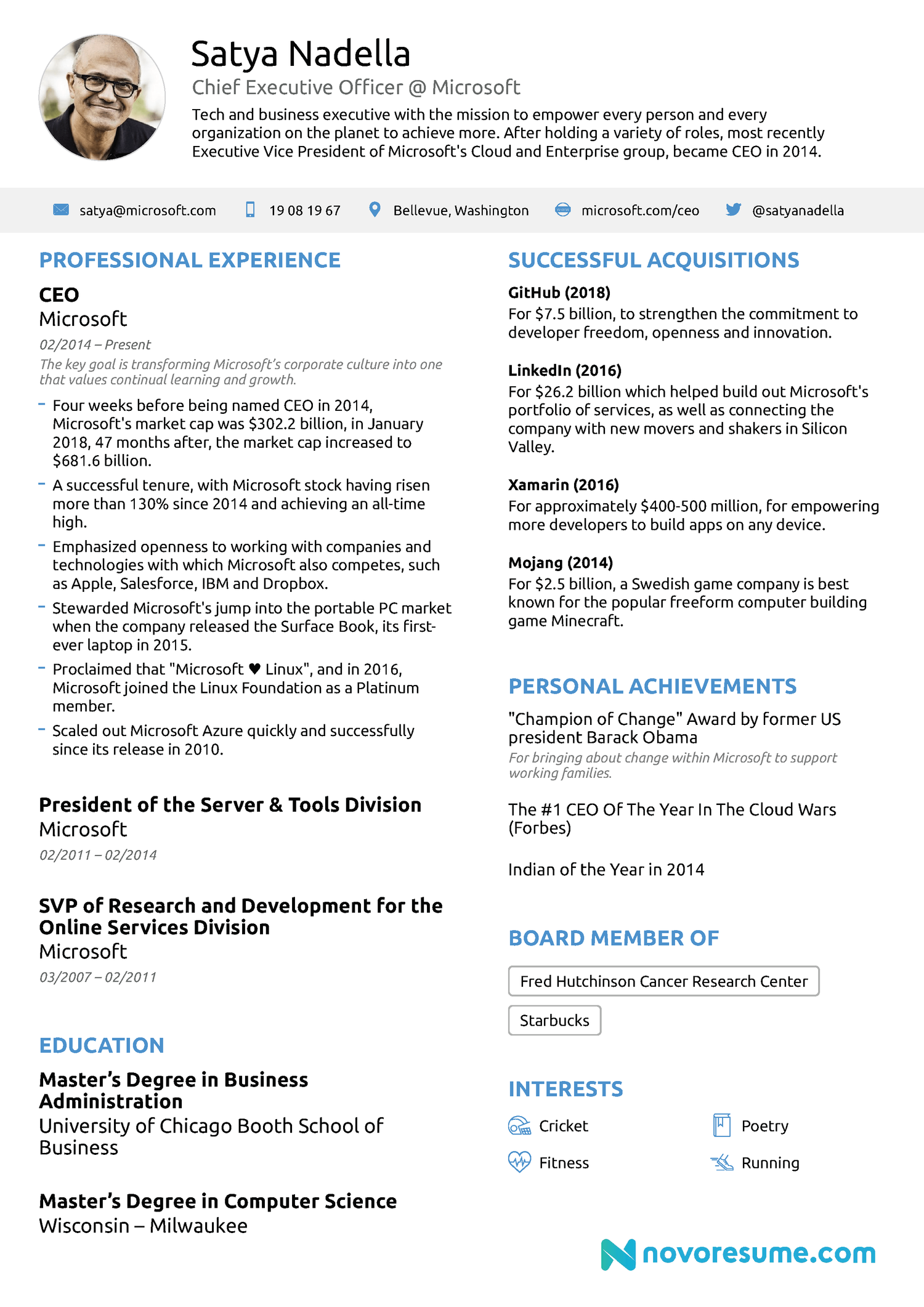
What Does a Chief Executive Officer’s Resume Contain
Before going into detail, let’s first go over the essential components of a CEO resume.
Those are:
- Header with contact information , where you add your full name and professional title, phone number, email, and LinkedIn profile /link to your professional website.
- Resume summary/objective , which is essentially an attention-grabbing introduction of yourself and your most noteworthy achievements.
- Work experience section, where you include your professional experiences, starting from the most recent to the least recent one.
- Education section , where you list your highest degrees, all the way to your Bachelor’s degree.
- Skills section , where you should list all the skills you have acquired throughout your career.
- Additional sections , such as certifications, foreign languages, awards, interests, memberships, and even volunteer experience.

How to Write a CEO Resume
Now let’s take a look at how you should write each section of your CEO resume:
#1. Choose the Right CEO Resume Format
The best CEO resume format is the chronological resume .
While both the functional and combination resume formats are decent alternatives, the chronological resume is ideal for people with plenty of work experience that is relevant to the position they’re interested in.
Additionally, you should also follow these formatting tips:
- Use clear and bold headings (e.g. H2) to identify the different sections of your resume.
- Pick the right font size and style to ensure your CEO resume looks professional.
- Allow plenty of white space around your resume margins , as they give your resume a clean look.
- Save your resume as a PDF file —it never messes up your formatting, it’s compatible with any system or device, and it looks way more professional than MS Word.
As a CEO, you probably have more professional experiences to show for than other people. This means you don’t have to limit your CEO resume to the recommended one-page length .
#2. Write an Impactful CEO Resume Summary
Your resume’s summary serves as a quick introduction to your professional profile.
It is important because, in just a few sentences, it can sum up your:
- Achievements
As such, an effective CEO resume summary can help grab recruiters’ attention like bees to a honeypot and ensure you the executive position you’re after.
Use the summary to give a detailed account of your executive experience based on some of your most noteworthy measurable achievements.
Here’s an example of a winning CEO resume summary:
Marketing executive with the mission to innovate and improve overall company performance. With a long career in public affairs, I am now Executive Vice President of Ketchum Inc.’s Technology Industry. Expert at Digital Strategy and Analytics.

#3. Pay Attention to Your Resume’s Professional Experience Section
The work experience section is the core of every CEO resume.
This is where you show off your decade’s worth of work experience and achievements. Here’s how to do it right:
- Start with your current/most recent position, continue with the one before, and so on.
- Begin each entry with your professional title, followed by the company name, the dates you’ve worked, and 5-6 of your achievements listed in bullet points.
- List fewer responsibilities and achievements under your older jobs (e.g. 1-2 bullets).
- Make your achievements as quantifiable as possible (e.g. “company stock achieved an all-time high of 120% within a 2-year period”, as opposed to “increased company stock”).
- Don’t let your work experience section be bland. Instead, use active voice and action verbs (e.g. achieved, stewarded, increased, led, emphasized).
- Don’t write a one-fits-all professional experience section. E.g. If you're applying for two positions, use your diverse work experience to customize your resume based on the job description, instead of applying with a one-size-fits-all CV.
Sounds simple enough, right? Now, let’s look at a concrete work experience section of a CEO resume:
Professional Experience
Chief Executive Officer
01/2017 - 08/2022
- Successfully led teams of over 400 employees in 3 locations.
- Initiated transition to mobile technology, which is now responsible for 50% of overall sales.
- Promoted closer cooperation with tech companies, thus reaching a new age demographic that increased profits (18-25 years old).
- Increased company revenue by 150% in a 3-year span.
Senior Manager
Best Place Group
06/2012 - 12/2016
- Increased client retention rate by 170% by implementing cutting-edge technology such as e-services and mobile payment.
- Exceeded company’s KPI-s by 70% within the first six months of being a senior manager.
#4. Don’t Overlook Your Education Section
Your education section comes right under your professional experience and is similarly important when it comes to your CEO resume.
Follow these guidelines to make sure your academic background shines through:
- Begin with your latest (and highest) degree first, followed by the institution’s name and location, and the years attended.
- If you have two Masters’ Degrees or a second advanced degree, continue by including it in your education section.
- Leave your high school education out of your CEO resume.
Let’s look at how that looks on a CEO resume:
Ph.D. in Business Administration College of Business Administration - University of Illinois, Chicago 2013 - 2015
MSc in International Business Management GISMA Business School, Berlin 2012 - 2013
#5. Highlight Your CEO-Related Skills on Your Resume
According to statistics, there are over 11,293 business executives currently employed in the US.
That’s not a small number of CEOs to be competing against. For this reason, you have to make sure it’s not just your professional experience and education background that stands out, but also other sections such as your skills, certifications, interests, and awards, among others.
Here’s how you should list your skills on your CEO resume:
- Identify your skills, including both soft skills and hard skills. The skills you identify can be both management and CEO-related, as well as industry-related.
- Read the JD of the role you’re applying for and scan it for any keywords that match the required skills for the job.
- Among your relevant skills, make sure to include those that appear on the job description (as long as you possess the said skills, that is).
25+ CEO Skills to Use on Your Resume
To give you a head-start here’s a list of CEO-related skills that you can use in your CEO resume:
- Business Strategy & Planning
- Work under pressure
- Business finance
- Management operations
- International business
- Business law & business Ethics
- Attention to detail
- Accountability and determination
- Accounting and finance management
- High-stakes negotiation
- Risk management
- Business analysis and intelligence
- Organizational restructuring
- Public relations
- Project management skills
- Verbal and written communication skills
- Management skills
- Decision-making skills
- Critical thinking Skills
- Interpersonal skills
- Creative thinking Skills
- Time management skills
- Problem-solving skills
- Technical skills
- Leadership skills
- Collaboration and teamwork
- Risk-taking
- Adaptability
- Reliability
#6. Make Sure to Include These Additional Sections
There’s a fine line between great and perfect, and including some additional sections to your CEO resume is what can help you achieve the latter.
The following sections can help you stand out from other executives applying for the same position and give your resume the individuality and diversity a truly successful CEO needs:
- Certifications , such as Project Management Certifications (PMC), or Sales Certifications.
- Personal achievements , including professional recognition outside your industry.
- Awards , especially job-related ones.
- Memberships , (e.g. Board Member of the XY Medical Research Centre).
- Hobbies and interests , (e.g. fitness, poetry, traveling).
- Foreign languages , with special emphasis on languages you’re fluent in.
#7. Attach a Cover Letter to Your CEO Resume
Including a cover letter matters just as much as your CEO resume when it comes to your executive job search.
It’s important to have one because:
- A cover letter for an executive position is just as essential as for any other position.
- It allows you to provide additional relevant and interesting information about your skills and executive experience that your CEO resume doesn’t.
Here are some instructions on how to best write a cover letter :
- Start your cover letter effectively and make sure to include an impactful introduction.
- Use the body of your cover letter to describe your executive experience and management skills in a more engaging and detailed way than in your resume.
- Include achievements that support your CEO resume claims and prove your capabilities.
- End your cover letter with a strong concluding statement and a call to action.
- Consult our guides on cover letter tips and cover letter mistakes to ace your cover letter.
CEO Resume Template
Creating your CEO resume from scratch might turn out to be more time-consuming than you originally thought.
Traditional software like MS Word can give you a hard time formatting your resume exactly how you imagine it, while their templates are outdated at best and boring at worst.
Nóvóresume’s free resume templates instantly solve all those issues. You have 8 free resume templates to choose from—executive resume template included!

By using Novoresume’s free resume builder , you save time and effort by only having to focus on properly listing your skills, achievements, and qualifications.
Key Takeaways
And that’s a wrap on all things CEO resume-related. By now, you should be equipped to write a top-notch CEO resume and continue climbing the success ladder.
Let’s go over the article’s main points again for good measure:
- Your CEO resume should contain a header with contact information , a resume summary/objective , a work experience section , your education background , a skills section , and additional sections , such as certifications, awards, interests, etc.
- Choose the chronological resume format to build your CEO resume.
- Write a resume objective if you don’t have extensive experience as a CEO. Otherwise, add an impactful resume summary to your CEO resume.
- List relevant quantifiable achievements under each entry in your work experience section.
- Some additional sections you can add to your CEO resume include certifications, personal achievements, memberships, and foreign languages.
- Use a ready-made template to save time and effort when you’re writing your CEO resume!

To provide a safer experience, the best content and great communication, we use cookies. Learn how we use them for non-authenticated users.
The opinions expressed are solely those of Find My Profession. Click to see our Advertising Disclosure.
![how to write a good executive resume Executive Resume: Examples & Writing Tips [+3 Templates]](https://www.findmyprofession.com/wp-content/uploads/2023/02/Executive-Resume-Examples-Writing-Tips-3-Templates.png)
Executive Resume: Examples & Writing Tips [+3 Templates]
Learn how to write an executive resume with resume examples, templates, executive summary sample, skills, format options, tips, and a cover letter sample.

In a hurry to create the perfect executive resume?
Click on the resume sample below to download it.
If you need tips on how to customize your executive resume, keep reading.
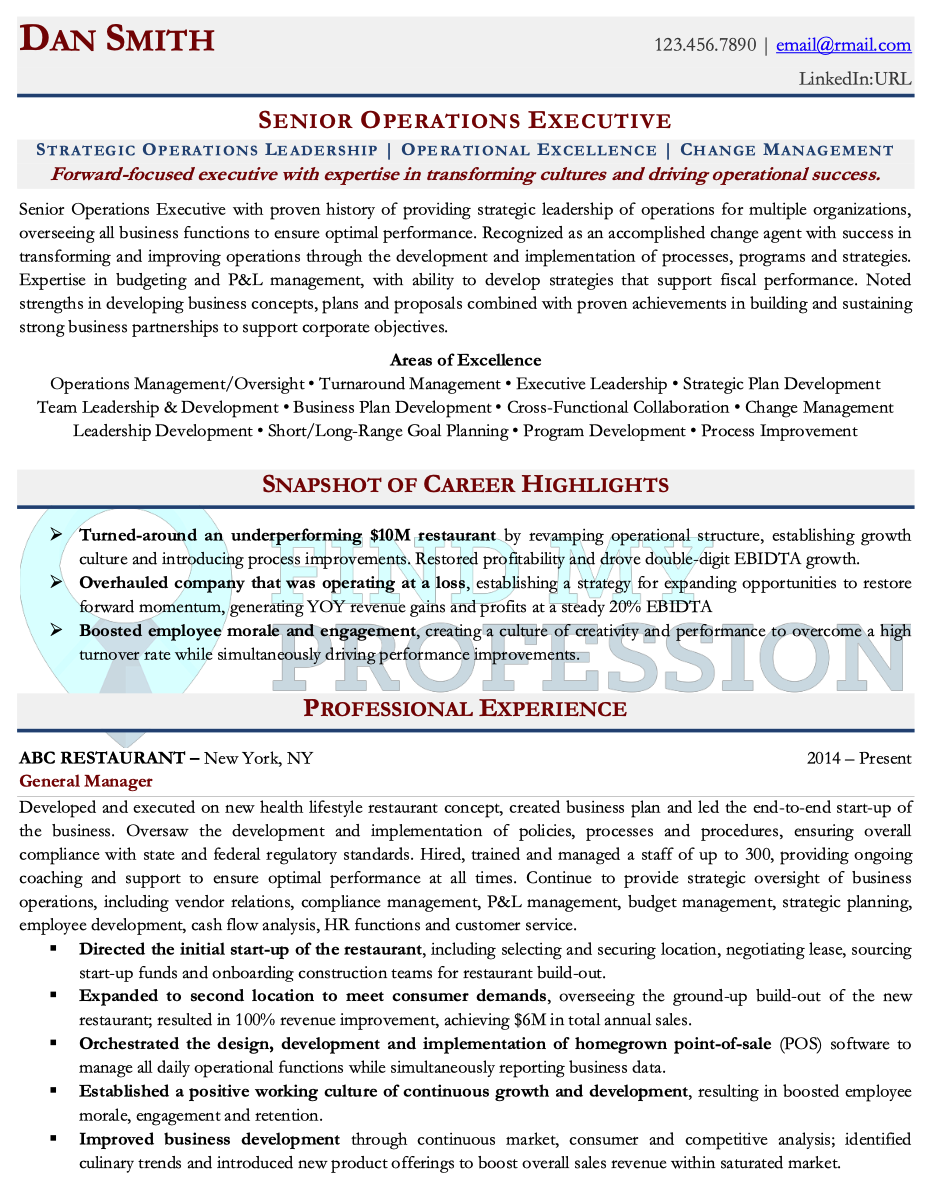
Additional Executive Resume Examples
We have also included Marketing and Finance resume samples!
Click on a sample below to download the full resume sample.
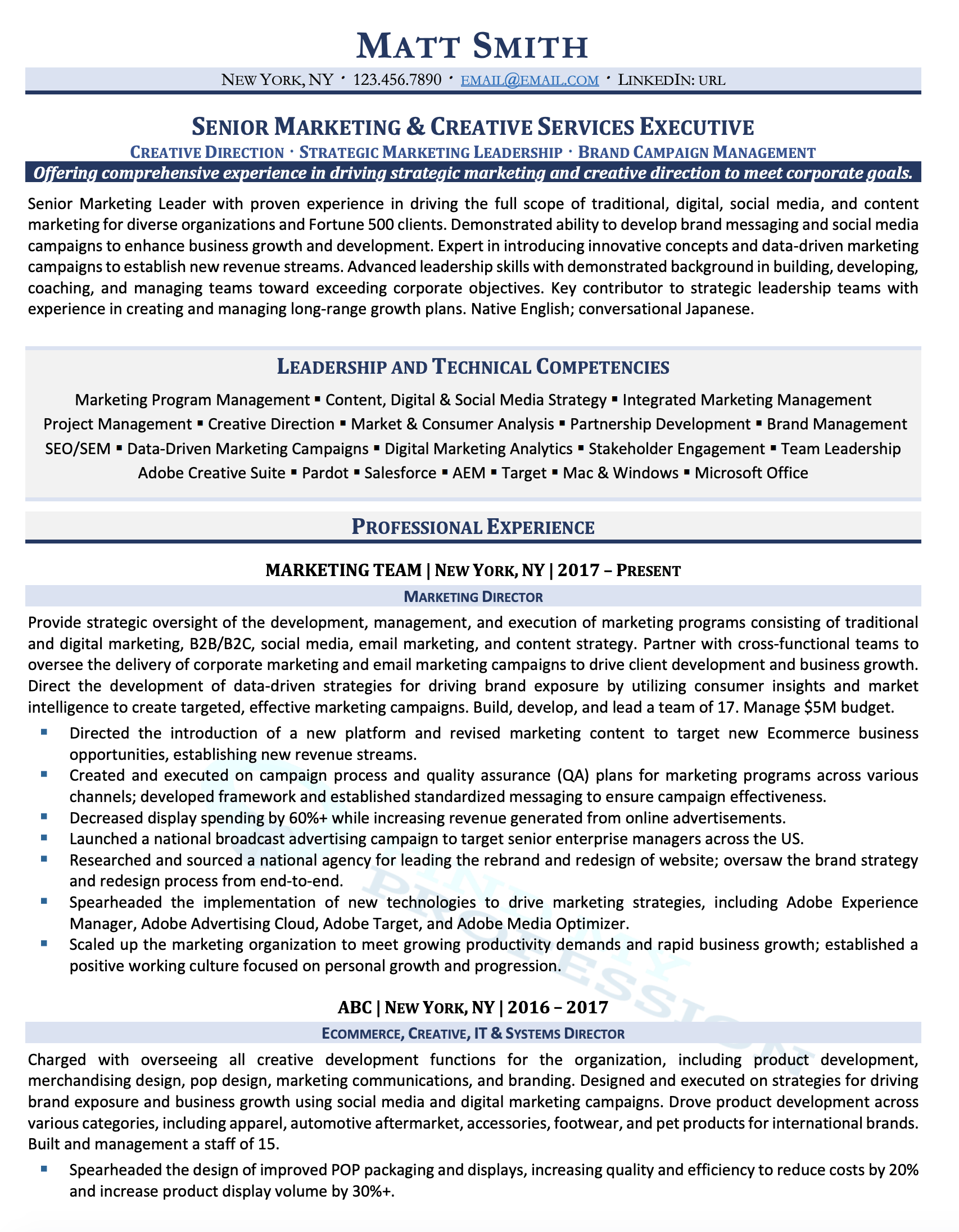
Check out even more executive resume examples on our website!
Include an Executive Summary on Your Resume
You’ve seen the templates and some formatting options, so let’s dive into customizing your executive resume for you .
Leadership, sharp perception, business acumen, and strategic thinking.
What else does an executive position require you to do?
Demonstrate that you possess all that and much more in your executive resume summary!
A resume summary, or executive summary, is one of the elements of your resume that gets a hiring manager’s attention in the first few decisive seconds. So you have to make it count.
How can you do that?
Simply by personalization and being highly relevant.
You should craft a summary that gives the most impressive overview of your executive career as well as demonstrates how your expertise and experiences will help solve the company’s pain points.
Include your most impressive roles and achievements along with a hint at how your career so far makes you the best candidate for that specific role.
While selecting your roles, skills, and achievements, give utmost importance to the ones that show your leadership and decision-making capabilities as an executive and the actual impact of your decisions and efforts so far.
If you can quantify the impact and relate it to any major challenges the company is facing right now, even better!
For example:
Suppose, you have led a team of customer analysts at XYZ Corp that enhanced the customer journey or led to a precise personalization of marketing messages, which in turn, increased the customer satisfaction score by 20%.
Luckily, from your research, you have found that the company you are applying to now is in the middle of doing something similar with their customer analysis efforts.
Bam! You have your leverage.
That’s what personalization of your executive summary looks like.
Your executive resume summary should be 4-6 sentences long. Use keywords from the job description to help describe yourself as the most fitting candidate for the role.
Take a look at an executive summary example:
Senior Marketing Executive with verifiable achievements in providing the full scope of global advertising, brand development and multi-platform marketing strategy. Record of success in building and mentoring top performing teams by driving cultural improvements and supporting employee growth. History of redefining brands through high-impact, ROI-driven advertising and marketing strategies that deliver tangible results in brand visibility, customer experience and revenue growth. Versatile change agent and executive leader with strengths in encouraging buy-in amongst all levels of an organization and utilizing data-driven concepts to deliver sustainable revenue gains across competitive markets.
Here, the applicant was aware of the organizational challenges the company was facing, such as redefining their brand and has leveraged that expertise in the executive summary.
Try writing your summary after you have completed the rest of your resume. It will be easier to see your most impressive and relevant experiences.
(Find more information about writing your executive summary in this article .)
Hard & Soft Skills for Your Executive Resume
The skills you use on your executive resume need to show that you are a strategic leader.
Do not just list every single skill that you have.
Applying for executive-level roles won’t require you to show any skills that you used when you worked at a cafe twenty years ago.
You should stay away from task-focused skills that will make you look like you are applying to lower-level roles.
Check the job description of the job you are applying for to see what skills they seem to be seeking. The keywords used in the job description will often be the same keywords you should use on your resume.
Here are hard and soft skills examples to use on an executive resume:
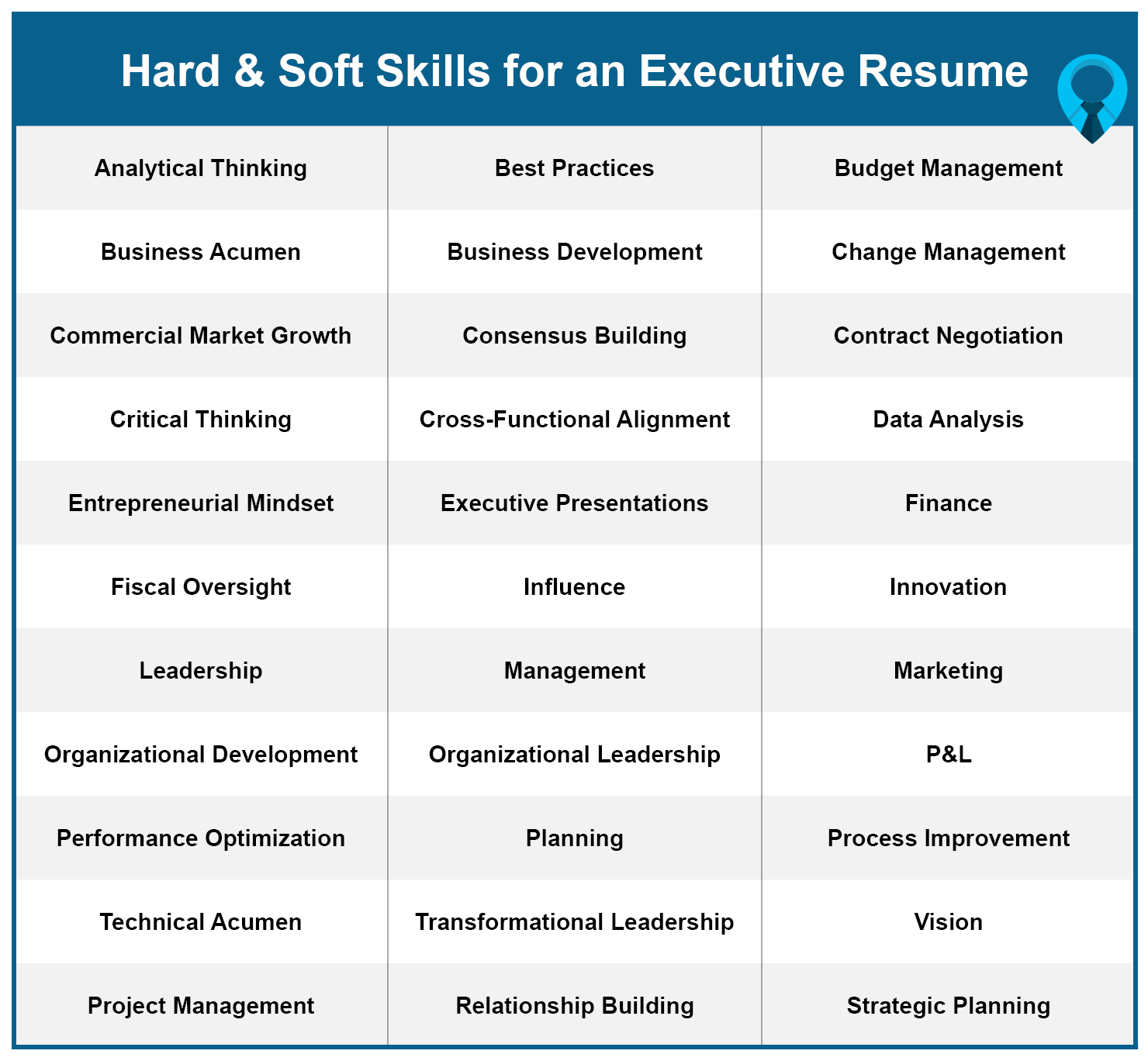
When writing the skill section of your resume, if you present a list of skills that looks like a soliloquy, that isn’t going to be interesting. Instead, ensure that you only include the skills you possess that are relevant and valued.
However, you don’t want to make it look like you have very few skills either; it is a balancing act. You need to show aptitude without going overboard.
Keep the number of skills in the skills section of your resume to 10-15 to be on the safe side. They should be a mixture of hard and soft skills.
If you have 16 solid, relevant skills, don’t panic about cutting one out. It’s a guide, just aim to be around 12-15. If you can only think of 10 high-quality skills, don’t add two obscure skills just to get to 12.
There are endless formatting designs for the skills section of your resume and you can label this section of your resume with different titles.
Instead of “Skills,” you can use a section title like “Areas of Expertise,” “Areas of Excellence,” “Core Competencies,” “Signature Competencies,” or “Leadership and Technical Competencies.”
Here is an example of the skills section of an executive resume:
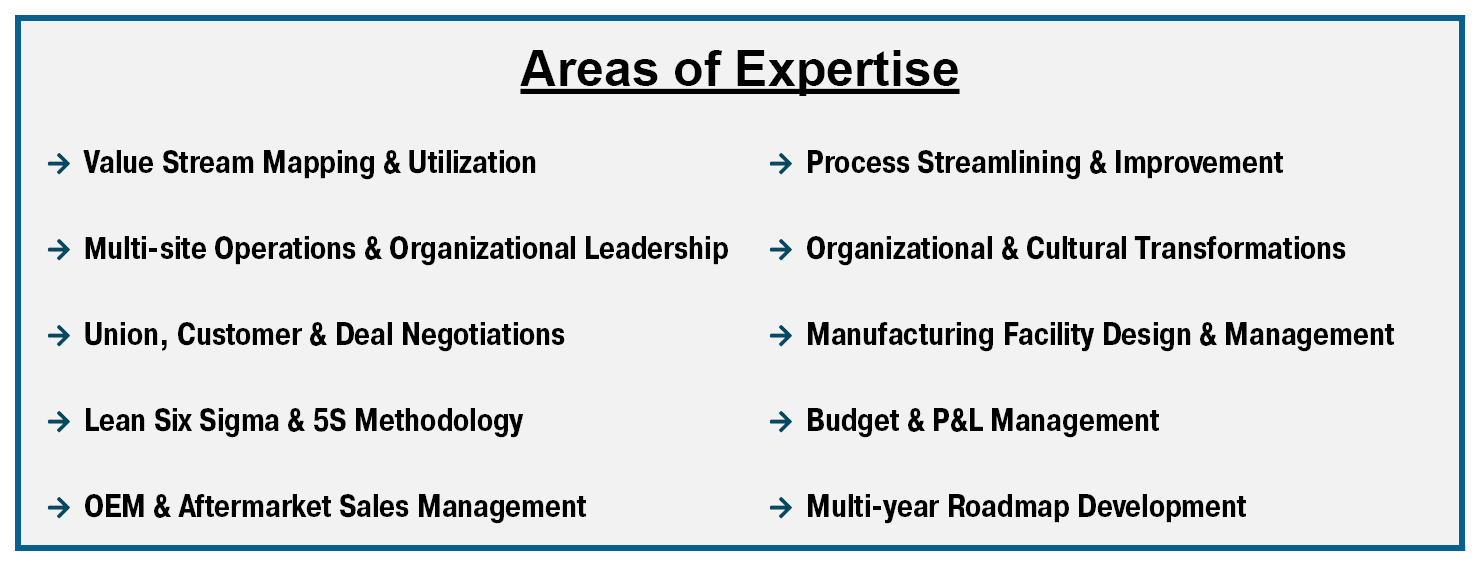
Check out the skills section in the resume samples provided above.
(For more information on skills for your resume, read Most Important Skills for a Resume .)
Prove Your Achievements On Your Resume
Anyone can type a laundry list of skills into a resume.
But can they prove their skills and achievements with numbers and examples?
Quantify Your Accomplishments
Metrics are king on a resume, and definitely on an executive resume.
Whenever possible and wherever relevant, quantifying your successes looks significantly better than just alluding to them.
If your neighbor told you that they took your dog for a walk for a while when dog-sitting for you, that’d be nice.
But if they said they took the dog out for 2 hours, we’d really be getting somewhere.
Quantifying the fact gave significantly more clarity. And you know that the dog needs a drink!
The same applies to your resume. Any time that you are listing an achievement, try to quantify it.
The achievement stays the same, but the person reading about it gets better information if you include a number.
For example, instead of:
Worked at ABC Company for 6 years and streamlined our service to increase net profit.
You can say:
Increased net profit 17% through the introduction of cost control initiatives and automated systems.
You say the same thing, but one way is significantly more enticing.
Additionally, if there is an accomplishment that you can’t easily put a number to, you can add an adjective to it.
Organized an event? Well, don’t just say “organized an event”.
An event where the attendance or donation goal was slightly missed was still organized.
Say that you “organized a successful event.” If you can’t state how much you beat a goal by, include the number of attendees or amount of money raised if it was still significant.
Here are some additional examples of quantifying successes on a resume:
Established a centralized mixing facility that improved tire division warranty and quality revenue. Restructured the facility after four years to generate a $4M savings in cost structure.
Drove a 30% reduction in inventory through the development, negotiation, and implementation of a plant storeroom vendor managed inventory program.
Improved employee on-boarding process and implemented a six-month new-hire training program to drive a 25% reduction in employee turnover.
Established a client-centric culture, focused on creating, innovative and effective marketing/advertising strategies, resulting in 25% new and organic revenue growth in 2019, positioning team as top-performer across agency network.
Created a comprehensive global marketing strategy that increased brand recall 11 points, improved net promoter score (NPS) 10% and boosted annual revenue 22%, achieving $28.4B.
Ensure your executive resume stands out with numbers and statements like those above.
Show How You Achieved Success
The person reading your resume are under no obligation to believe you.
That doesn’t mean that they’ll assume that you are lying. But it is easy to make claims that sound good. But without backing them up, what is the use?
Are you telling the hiring manager that one of your skills is project management?
Well, highlight how this was demonstrated. How did you control costs? How did you lead your team? How did you manage suppliers?
Otherwise, your claims will seem very insipid.
Check out some examples showing how success was achieved:
Increased cash flow by over $1M over a period of 7 years by improving tax planning and researching/utilizing federal R&D tax incentives.
Improved reporting accuracy and timeliness by creating a comprehensive financial and managerial reporting process and obtaining buy-in from key process participants.
Improved efficiency and automation levels by expanding the existing utilization of Salesforce CRM from just the sales department to the entire organization. Led the integration of Salesforce with Microsoft Dynamics SL.
Reversed 7 weeks of churn caused by competitor’s marketing attack by rolling out a new high-profile advertising campaign across multiple platforms; restored pre-attack churn levels in under 6 weeks.
Improved employee morale and engagement by establishing an employee “Impact Award” that recognized and rewarded employees for innovation in safety, quality, and efficiency improvements.
If you can show results and how you accomplished those results, you successfully subsidize your claims.
(Learn more about turning duties into accomplishments on your resume .)
What is the Best Format for Executive Resumes?
There are a number of resume formats to use and we will explain the differences and when to use them below.
Chronological Resume Format
The chronological format is the most used format for executives, and with good reason.
We would advise that you use this format too, as it focuses on your professional work experience.
That is exactly what recruiters want to hear about when you are pursuing a position like this.
Including key details about your recent employment experience puts you in the best position to catch the eye of the recruiter.
You will list your professional work experience in reverse-chronological order with the resume format, describing your duties and accomplishments in each of your recent roles.
Combination Resume Format
If the chronological format does not work for you because of a recent gap in employment or you are changing careers, use the combination resume format.
Your key transferable skills will be highlighted before your work history with this resume format.
Your resume is for an executive position. As such, work responsibilities and achievements will be a huge determining factor on your candidacy, so ensure that you give your previous employment section the attention it deserves.
We emphasize that the chronological format is the more effective of the two if you can choose between them.
Avoid the Functional Resume Format
On an executive resume, you don’t want to completely remove focus from your professional experience.
That is exactly what this format does as it prioritizes skills and only provides a high-level view of your experience.
Yes, you get to highlight your key skills and achievements with this format, but you also need your resume to focus on what an executive recruiter wants to know about you. If you don’t include the details of your employment history, you may look like you are hiding something.
(For more information, and for samples of how these formats look, read The 5 Best Resume Formats ).
How Long Should Your Executive Resume Be?
There are some questions that can come up as you create your resume to target executive-level roles.
We will address the length of your resume as well as some common issues for executives.
Your Executive Resume Should Be 2 Pages
Should your resume be one page as an executive? Is two pages the maximum length for an executive resume?
The short answer is “no.”
But the longer answer highlights that the recommended length can vary.
The goal of your executive resume should be 2 pages. As an executive, you will need to cover too much experience to fit on a one-page resume.
But if your resume reaches three pages, should you be concerned? Should you adjust the line spacing and font size to get it down to two pages?
But only if everything that you have included on your resume helps sell you for the position you are targeting with that particular resume.
If there’s a lot of space taken up with information that is not adding much value, then cut those sections out. The length of your resume isn’t so rigid here.
Some executives just can’t limit their relevant accolades and experience to two pages. If this is you, you are not expected to downsize your resume.
Do Not Go Back More Than 15 Years (Even If Tempted!)
You do not want to look like you are relying on your work experience from over a decade and a half ago to get you a job today.
If your resume is covering details of your accomplishments and skills when George W. Bush was first taking office, things will look quite dated. And sadly, so will you.
Times change. And so do you.
If you cannot sufficiently demonstrate your aptitude from your last 15 years of work experience, then that is not much use.
If your resume says that you held 3 different positions recently, each for less than 6 months, but won an award in 2002, the award is not going to be what stands out.
You want to be giving evidence of your continued success, and that is best achieved by including the most up-to-date information.
You can include a small section on your resume titled “Earlier Career” or “Additional Experience” which can list job titles and companies from prior to 15 years ago if needed.
Got a fantastic accomplishment from prior to 15 years ago? That could be an award or similar. You may include it, but you are better off omitting the date.
Most Resumes Will Only Be Read for a Few Seconds
You spent hours and hours perfecting your resume. You completed every section of your resume.
And then it gets less than 10 seconds of attention before being placed to the side.
How do you ensure that this isn’t something that happens to you?
Keep your content relevant to the role you are applying for and only as long as it needs to be.
Hiring managers do not want to sift through 3 pages of your experience and accomplishments that have nothing to do with the role they’d like to see you in.
Don’t sound generic and boring, especially in the top sections of your resume.
Instead, be engaging. Hit the reader with impressive numbers, make them want more from the start.
Fantastic statistics halfway down the page will hardly matter if the reader doesn’t get that far.
Make bold points, not bland points.
If you can use numbers to back your statement up, do so. It makes your claim a lot more substantial.
Should You Hide Your Age On Your Resume?
Are you concerned about your age getting in the way of getting an interview?
Perhaps there is a stigma attached to you being considered too young or too old for the position.
We have some do’s and don’ts to hide your age on your resume.
First, do not lie about dates worked or the dates of your education. The truth can easily be found by your potential employer.
However, you can omit the dates of your education.
If you fear you will be looked over because of your older age, make sure any statements about how much experience you have don’t make you sound like you have too many years of experience.
If you are an older executive, including only your last 15 years of experience (as mentioned above) won’t highlight exactly how many years you have been in the workforce.
Another key way to hide age is to distract the reader with the most relevant skills. Recent experience and skills will do a fantastic job of framing you as a qualified and up-to-date candidate.
Your age won’t be relevant if you appear to be a perfect fit!
Executive Cover Letter Example
Once you have completed your resume, crafting a stellar executive cover letter won’t be much of a hassle.
You will just need to pick the best parts of your resume and present those details in the form of a letter.
Below is an example of an executive cover letter. Click on the image to easily customize the letter for yourself.
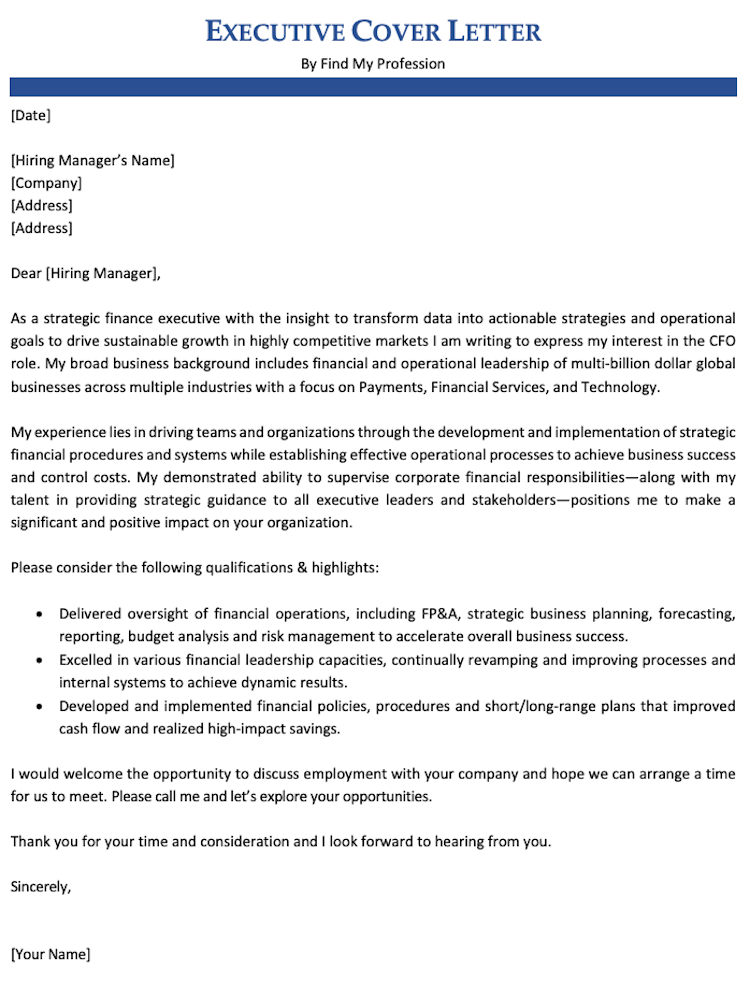
Keep these executive cover letter writing tips in mind:
- Address the letter to the hiring manager by their name.
- Just like you did for the resume summary, include your most impressive and relevant details in the opening paragraph.
- Present your career highlights in a bulleted list containing all of your most impressive and relevant skills, experiences, accomplishments, awards, and other details.
- End your letter with an open call to action inviting the hiring manager to chat about how your executive acumen would help their organization progress on their path forward.
- For finding the perfect tone and voice, study the company website, LinkedIn profile, and other publications and follow their brand voice.
- Keep your letter under one-page and around 350-400 words.
- Formatting and styling should be the same as you used on your resume.
With these tips at your disposal, you are on your way to creating the best cover letter the recruiter is going to ever receive.
Key Takeaways
And there you have it.
Everything from what to write in your executive resume to how to write it has been covered.
Here is a summary of the key information in this article:
- Include key sections in your executive resume including a summary and a space dedicated to your skills.
- Personalize your executive summary to be relevant for the job you are applying for with your top skills and keywords from the job description.
- Include executive-level and relevant skills in your resume. Study what skills the recruiter wants, and then include the skills that you possess in your resume.
- Quantify and your experiences and accomplishments when you can.
- Keep your executive resume to 2 pages if possible.
- Include a cover letter to highlight your best accomplishments and why you are the best fit for the job.
- Use an executive resume writing service if you need to. Resume writing isn’t for everyone. There is no shame in making an investment to ensure that you get the best possible outcome.
Use these tips to create an executive resume on your own. Good luck with your job search!
Recommended Career Advice For You

10 Best Resume Writing Services in Tampa, FL (2024)

10 Best Staffing Agencies in Ottawa, ON (2024)
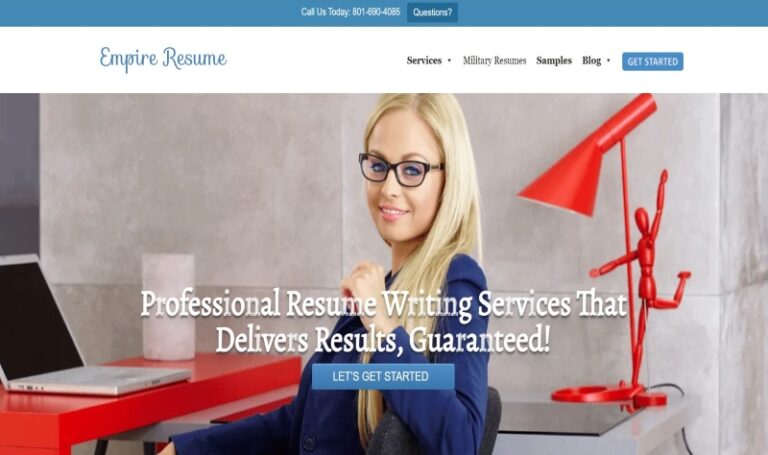
Empire Resume Review [Cost + Customer Reviews]
- Skip to primary navigation
- Skip to main content
- Skip to primary sidebar
- Skip to footer
Executive Career Brand™
Executive Job Search - Personal Branding, Executive Resumes, LinkedIn Profiles, Biographies, etc.
October 9, 2023 By Meg Guiseppi
How to Write An Irresistible Executive Resume in 10 Steps
- Pinterest 3
- LinkedIn 76

When was the last time you used your executive resume?
When was the last time you even thought about it or looked at it?
If you’re like many executive job seekers, you’ve either never needed a resume to get noticed and land a job . . . or it’s been many years since you’ve needed one . . . or you’re not happy with your resume.
You may be unaware of how much executive resumes have changed in just the past few years.
Your executive resume may be dangerously old-fashioned.
Before dusting off your old resume (if you have one), merely updating it with your latest contributions and career history, and expecting that, when you put it out there they will come, you need to get a handle on today’s modern resume and what part it plays in the new world of executive job search.
And guess what? A great resume alone probably won’t get you into your next great gig.
Your paper/digital resume will probably NOT be your first introduction to recruiters and hiring decision makers. Many surveys show that the vast majority of them social recruit. That is, they source and assess candidates through Google search, LinkedIn, Facebook, Twitter, and other social media.
If you don’t have a strong online footprint providing them with plenty of on-brand information supporting your value proposition, you’re likely facing a prolonged job search.
All things being equal – skill sets, qualifications, relevant experience, education, etc. – job seekers with stronger online presence are the ones who are noticed and chosen over those who have little or no presence online.
So why bother with an executive resume at all?
Why not go straight to your online personal and career marketing? Three good reasons:
1. You need to get your brand and value proposition together before moving them online, so that you send a clear consistent message across all channels. Slapping up a LinkedIn profile, other social media profiles, a website, or web portfolio before doing the initial branding, targeting and research work is a mistake.
2. You’ll still need a paper/digital resume at some point in the hiring process – it’s still recognized job search currency. So make sure it’s a knockout.
3. The work you do defining your personal brand and developing content for your resume (and bio and other career documents) forms the foundation for all your personal marketing materials, online and offline, and offers many benefits:
- Helps you develop messaging designed to resonate with your target audience.
- Energizes you with what differentiates your unique promise of value from your competitors.
- Prepares you to speak confidently and knowledgeably about the value you offer.
- Provides a wealth of on-brand information to repurpose for each of your online profiles and any web pages you create.
- Prepares you to network and interview well.
Understand that before you can write a great resume , you need to lay the groundwork with these critical first-steps – targeting, research and personal branding.
Also understand that you should ALWAYS include a cover letter when you send out your resume. Some people won’t care, but you never know who will care, and who will toss you out of the running if you don’t include one. So play it safe.
Write an Executive Resume That’s a Knockout
My 10 steps below provide the basic guidelines to write your executive resume . But to do an even better job, use my Executive Job Search Worksheets Package .

This includes an in depth Career History Worksheet, along with the other 3 comprehensive worksheets I actually use with my clients . . . to write knockout LinkedIn profiles, executive resumes , biographies, cover letters, etc.
The 4 worksheets combined will take you beyond writing your executive resume to help you position yourself to land a great-fit new gig!™
10 Steps To Write an Irresistible Executive Resume
Remember, I’m using the word “resume” but, along with creating a paper/digital resume, what we’re doing here is developing your personal marketing messaging for all your brand communications, offline and online:
Information-mining and development
1. targeting and research.
Identify the employers you want to work for and research each one to discover their pain points. What current pressing needs do they have that you can help them with?
If you don’t write to a specific target audience, your resume won’t speak to the recruiters and hiring decision makers reading it, or help them connect you to the job they’re trying to fill.
They don’t have the time or inclination to sift through irrelevant information to see if you warrant interviewing.
Everything in your resume has to align with what they’ll be looking for in candidates.
2. Personal Branding and Value Proposition
Branding is not optional anymore. In a nutshell, branding links your passions, key personal attributes, and driving strengths with your value proposition, in a crystal clear message that differentiates you from your competition and resonates with your target audience.
The things that differentiate your unique promise of value from your job seeking competitors is what will sell you.
Companies are looking for vitality, good fit, and personal chemistry in executive candidates. Branding generates chemistry and makes you come alive on the paper, digital, and web page.
3. Career Success Stories
Storytelling helps you explain how you make things happen – how you were able to capture profitable advances for your past employers.
It helps your target audience zero in on what you’ll do for their organization. They begin to picture you doing the same things for them.
Follow a “Challenge – Actions – Results” (C-A-R) framework to illuminate your critical contributions to employers.
Concise C-A-Rs stories are especially helpful in preparing for interviewing. See my post, How C-A-R Storytelling Gives Executive Resume Branding Zing .
Use your C-A-Rs stories to help you develop value proposition messaging that is monetized and linked to your personal brand. SHOW THEM THE NUMBERS! And show them how you accomplished those advances with specific examples.
Write your executive resume
4. resume headline.
Don’t lead your resume with the job you have now. Use the job you’re seeking with that particular employer, that your whole resume has been customized for.
Back that up with a few of your top areas of expertise, for a headline such as:
Vice President | SVP Technical Operations | CTO – Airline Maintenance Operations Predictive Maintenance Expert Process & Performance Improvement and Transformation with available resources
Or, maybe even better, with a brand statement, for a headline such as:
CERTIFIED CHIEF INFORMATION SECURITY OFFICER A clear, transparent communicator and trust-building business leader, I can talk about cybersecurity without using one technical word
5. Real Estate and Strategic Positioning
Busy executive recruiters and hiring decision makers typically allow only 10 seconds or so for a resume to draw them in. They may read no further than the top part of the first page when screening your resume.
You need to capture and hold their attention right there, and compel them to want to read the entire document.
Solution: Brand yourself above the fold.
As much as possible, make that section stand on its own as your calling card. Some suggestions for above the fold branding:
- Generate chemistry by balancing your personality with your hard skills, or relevant keywords.
- Add a powerful quote from a recent performance review or someone you work with.
- Include 3 or 4 value-driven bulleted statements with metrics.
- Instead of just including keywords here, provide an example of how you benefitted the company by using that area of expertise of yours.
And, while we’re looking at the above-the-fold area: Show that you’re social media savvy.
Include a link to your LinkedIn profile, unless you don’t have one or it’s lacking much content. Also include other professional social media accounts (if you’re active there), along with your online publications and/or other supporting online info.
6. Readability
Many hiring decision makers review resumes on their phones, meaning tiny screens.
When they open a document or web page, it’s more likely to capture and hold their attention with concise statements surrounded by plenty of white space.
Avoid densely packed, hard-to-read information. Shorter chunks of information are easier to read and will draw the reader’s eye to continue down the page.
The same readability issues apply to people reading your resume on a large screen. Make it appealing looking and easy to read.
7. Typos and Grammar
Doesn’t it go without saying that typos and errors in grammar are the kiss of death? They may also convey misinformation. Proofread several times and have someone else do it, too.
Don’t rely on spellcheck. Make sure your contact information at the top of each page of your resume is correct.
8. Formatting
Keep the formatting attractive, consistent, and clean. Don’t use more than 2 different fonts (one for headings, another for content), and don’t choose frilly, unprofessional fonts. Use graphic lines sparingly, and avoid underlining text.
Debate continues over whether an executive resume should be no more than 2 pages , or even only one page.
Typically a one-page resume should be avoided because it likely won’t provide enough information.
But don’t sweat the resume length too much. If you stick to 2 or 3 pages, you’ll be fine.
Let the content drive the length of your resume. What’s important is positioning yourself as a good fit for the employers you’re targeting, based on which current needs of theirs you can help them with. And nothing you include should be arbitrary.
If you’ve had more than a handful of different roles over your career, you’re going to need some space to describe your contributions and the value you offered, using storytelling. That can easily take 3 pages, especially because you don’t want to cram in the content just to fit it to 2 pages.
A 3-page c-suite executive resume is perfectly acceptable. In fact, almost all the resumes I create are 3 pages, because they needed to be.
A tip: If your resume spills over to 3 pages, make sure the third page content fills up at least a third of the page. If you only have, say, 5-10 lines on the third page, you can surely edit and tighten things up so that your resume is only 2 pages.
And, with a 3-page resume, don’t hide anything important and relevant on that last page. Bring those things forward into the summary at the top of the first page.
9. Blah Resume-speak
Write your resume from your own voice. You’re not like everyone else. Find the precise words that describe what makes you unique and valuable.
Keep the content interesting and don’t fall back on dull phrases that don’t differentiate you, such as results-oriented, visionary leader, excellent communication skills, proven track record of success, etc.
10. Passive Verbs and Repetitive Job Descriptions
Avoid the over-used, boring phrase “responsible for”. Show your vitality with robust action verbs and explain your niche expertise with relevant keywords. Use strong words like pioneered, envisioned, accelerated, benchmarked, incentivized, leveraged, etc.
Don’t waste precious space in the “Professional Experience” section reiterating obvious responsibilities. Readers will already know the basic duties for your jobs.
Yes, your resume needs to have plenty of relevant keywords in it, but for the highly-formatted version, you can lighten up on them. Instead, jam-pack your ATS-friendly (or text) resume with relevant keywords. This is the resume version that will go into Applicant Tracking Systems (or databases) when you apply through executive recruiters, HR and online job postings. (More about this below)
More Executive Resume Tips
Executive job search strategist Adrienne Tom offers this additional advice:
- Customize content for every job – general resumes don’t work
- Make your value known
- No need to list all career history. 15 years of recent employment detail is typically sufficient
- Highlight top career achievements and provide the proof
- Focus on achievements, not tasks in your resume. Yes, everyone has results to share
- Lead with results and front-load points throughout for greater impact
- Let the resume be storytelling in nature
- Weave the right keywords throughout the file that relate to the target role and audience
- Use an active voice with lots of action words
- Employ a bit of strategic design to emphasize key content and make your resume look unique
- Include appropriate white space; make it easy to read
- Content is king, but presentation matters too
- Use strategic content to de-emphasize any employment gaps
- Remove any possible resume red flags to help improve application success
- Increase emphasis on soft skills — but be sure to be specific with examples
- Add pandemic career wins to your resume. Employers want to see how you adapted and succeeded these past few years
- Stay abreast of current resume trends. Keep up with modern strategies as the resume continues to evolve!
And Some Resume FAQs That May Apply To You
In what format(s) should i create my resume.
You’ll need 3 resume versions, for various purposes:
- A nicely formatted, visually appealing MSWord version.
- A PDF version so that formatting of the above will set up exactly as you meant it to.
- A stripped down, barely formatted text or ATS-friendly version to make it through Applicant Tracking Systems . This can be created as a Word document.
Some career professionals advise creating just one MS Word resume version that covers both bases – formatted for visual appeal but will also get the resume through ATS.
But there are more than 200 kinds of ATS out there. Some accept various enhancements and some don’t. You won’t know which version the company is using and how much formatting enhancement will be okay. It’s safer to have a designated ATS resume version as I described above for the times you know your resume is going into an ATS. And reserve the nicely formatted Word version for human eyeballs only.
More in my post, What’s the Best Executive Resume Format and Length?
How do I deal with employment gaps?
First, don’t panic.
If your gap is only a few months long, you may be able to somewhat cover it up by only using years on your resume, instead of months and years.
If you did any volunteer work , that can easily stand in for a job . . . whether or not you were paid.
If your gap is longer and you weren’t involved with any volunteer experience or relevant non-work activities, it may be best just to embrace the gap. Treat it as a “career break”.
But explain what you were doing in that gap, in terms that will resonate with your target employers and further support your good-fit qualities.
For more tips see my post, How to Deal With Employment Gaps in Your Resume and LinkedIn Profile
Do I really need to include a cover letter?
Studies have shown that even if hiring managers DON’T read them, they want to see a cover letter with a resume. And they often eliminate those candidates who didn’t include a cover letter.
Best practice is to include a customized cover letter that provides further info about you, beyond your resume.
You’ll never go wrong including a cover letter, but you can easily go wrong if you DON’T include one.
More in my post, Do I Really Need a Cover Letter for My Executive Resume?
Do I even need a resume if I have a good LinkedIn profile?
First of all, lose the mindset that LinkedIn is an online resume. If it ever was, it’s not any more. There’s a lot more going on at LinkedIn – social branding, networking, curating content, etc. – than the ability to publish your career history online.
For another thing, you can only have one LinkedIn profile, but you can (and should) have several resumes, customized for each of the employers you’re targeting, based on what makes you a good fit for them.
A LinkedIn profile needs to be somewhat more generic so it will appeal to a wider audience than just one employer. Obviously, you can’t customize your LinkedIn profile for each target company, but you can indicate your job-type and industry preference.
Your resume shines when you’re actively networking your way into the companies you’re targeting. To hit home with people, you’ll customize your resume (as much as possible) for each target company, and send it to select people at, or associated with, each company.
Unless you post your resume on job boards, which isn’t a great idea, only the people you send it to will see your resume. Not so with your LinkedIn profile. It’s there for the whole world to see.
More in my post, Does LinkedIn Make the Executive Resume Obsolete?
More FAQs on Writing an Irresistible Executive Resume
It’s advisable to update your executive resume regularly, even if you’re not actively job hunting, to ensure it’s always ready when needed.
Executive resumes should evolve to reflect changes in job market trends, technology, and employer expectations to remain effective.
A robust online presence is essential as recruiters and hiring managers often use social media to evaluate candidates. Having a strong online footprint can expedite your job search.
An executive resume is crucial because it serves as a foundational document for your personal brand and provides a comprehensive overview of your qualifications.
The critical first steps include identifying your target employers, conducting research, and developing a personal brand to craft a compelling resume.
Along with relevant career history, an executive resume should include sections like a resume headline, career success stories, personal branding, and value proposition.
Capture attention in the top part of the first page by including a powerful quote, value-driven bulleted statements with metrics, and links to your professional social media profiles.
Readability is crucial, especially since many people read resumes on mobile devices. Use concise statements and ample white space to enhance readability.
Typos and grammar errors can harm your credibility. Proofread your resume thoroughly and have someone else review it as well.
While there is some debate, a 2-3 page executive resume is generally acceptable. The content should drive the length, and it should be concise and relevant.
Use your unique voice and specific language to describe your qualifications and achievements, avoiding clichés like “results-oriented” and “proven track record.”
Bottom Line When You Write an Executive Resume
Always keep in mind that real people with particular sets of criteria are reading your resume. Put yourself in their shoes and give them the information they’re looking for in a document that’s easy to read and digest.
Make it easy for them to assess your “fit” for the position and corporate culture. Make it easy for them to hire you.
More Help to Write an Executive Resume
7 Things I Learned About Resume Writing That Changed Everything
20 Things NOT To Put in Your Executive Resume
Worried About Age Discrimination? 9 Things on Your Executive Resume That Show Your Age
5 Reasons Why Your Executive Resume Is Not Working
- Odnoklassniki icon Odnoklassniki
- Facebook Messenger
- LiveJournal
Reader Interactions
December 30, 2020 at 7:07 am
Great article Meg. I especially liked step 2 about personal branding. You’re absolutely right in saying that branding is now a necessity. It connects what you can do with what you stand for and provides a way for you to be different and memorable.
Employers aren’t hiring people just based on skills mentioned in resume but also on their authenticity and other traits which show their human side. Branding helps you have control over how you are perceived and what kind of emotions you trigger in your target audience.
December 30, 2020 at 8:43 am
Just like you said, Hitesh. Personal branding is the way you help employers (and others) understand what kind of person you are, and how you operate. Thank you for commenting!
April 23, 2020 at 12:05 pm
To whom it may concern.
Please show me the latest sample resume format with the ideas you have listed. Thanks and regards
April 24, 2020 at 7:35 am
Thanks for commenting, Erick. You can see samples here — https://executivecareerbrand.com/get-started-get-unstuck-executive-job-search-strategy-session/executive-resume-and-career-biography-samples/
- About Meg Guiseppi
- Contact Meg
- How I Will Help You
- SPECIAL OFFERS !!!
- Terms of Use
- Privacy Policy
Follow Meg here

IMAGES
VIDEO
COMMENTS
An executive summary should be the first thing on your resume, underneath your name and contact details. Your executive summary can include: The title of the job you're applying for. A short paragraph explaining the scope and context of your work experience. 2-4 of your most impressive accomplishments.
Examining executive resume templates is a good way to start to think about how your brand fits a specific executive position. For more executive resume templates, check out our Executive Resume ...
It's fast and easy to use. Plus, you'll get ready-made content to add with one click. See 20+ resume templates and create your resume here. Create your resume now. Sample executive resume made with our builder— See more resume examples here. One of our users, Brittanya, had this to say:
Examples of an executive's resume Here are a couple of examples of an executive's resume: Example 1 Ana Adams 134 Pond St., Madison, WI 53715 555-898-8855 [email protected] Professional profile: Solutions-based chief executive officer with over a decade of experience in the financial sector. Voted "Professional of the Year" by W Magazine for my work at an up-and-coming startup company.
Related: How To Create an Executive Resume Template (With Examples) 2. Include a header. A header provides other company executives a quick way to see who you are and how they might reach you. You might include your name in a larger or bold font along with your email address, phone number and location.
4. Highlight your core competencies in a separate section. Executive resumes are often longer than regular resumes, making it even more important to ensure the first half is compelling and emphasizes your most relevant information. This way, board members are more likely to read it to the end.
Pick Template. With Nóvóresume's free resume builder, you get to skip out on all the resume formatting hassle and focus on what matters - the resume contents. #2. Add Your Contact Information. The contact information section on a resume is as straightforward as it gets, so you might as well get it out of the way first.
A well-written executive resume should highlight tangible factors such as the following: Scope of work (number of locations managed, project value, P&L value) Relevant financial metrics (budgets managed, costs and/or time saved, revenue increased) Strategic goals accomplished. Initiatives led or implemented.
How to write an executive resume summary in 6 steps: Start with a strong personality adjective, such as "driven,""resourceful," etc. Follow with your job title and area of expertise. Add years of experience. Include the goal you want to achieve for the company. Name major achievements from previous positions.
An executive resume should be a professional document with the chronological format and a content-oriented layout.. Your resume should be one page long, but if you have an extensive work history, you can make it two or even three pages.. Make your most impressive achievements stand out immediately by listing them right after your resume summary, in the "selected achievements" section.
They're looking for someone who can lead and change things for the better. Bad example: Managed a team of 30 engineers. Good example: Coordinated the work of more than 30 engineers in the development, testing, and production phases of a $10M project in the aero composite niche.
How to create a template for an executive resume. Here are some steps to take to create an executive resume template: 1. Choose a resume design. Find a resume design to use for your template either online or on word processing software. When selecting one, try to find a simple one that accents your information well.
What does an executive do? How to write an executive resume (tips and tricks) The best format for an executive resume; Advice on each section of your resume (summary, work history, education, skills) Professional resume layout and design hints. Along with our sample resumes and builder tool, we will help you to show just how good you are.
This means you don't have to limit your CEO resume to the recommended one-page length. #2. Write an Impactful CEO Resume Summary. Your resume's summary serves as a quick introduction to your professional profile. It is important because, in just a few sentences, it can sum up your: Experience. Skills.
Keep these executive cover letter writing tips in mind: Address the letter to the hiring manager by their name. Just like you did for the resume summary, include your most impressive and relevant details in the opening paragraph. Present your career highlights in a bulleted list containing all of your most impressive and relevant skills ...
3. Outline your academic background. As an executive, your academic background is a crucial part of your resume. At this stage of your career, your high school degree is likely irrelevant. Potential employers are likely only interested in your bachelor's degree and master's degree. To outline your academic background, state the name of your ...
If you only have, say, 5-10 lines on the third page, you can surely edit and tighten things up so that your resume is only 2 pages. And, with a 3-page resume, don't hide anything important and relevant on that last page. Bring those things forward into the summary at the top of the first page. 9. Blah Resume-speak.
Below is an example you can refer to when writing your resume for the executive position: Lucy Shine. 48 Golden Road, Queensland. +61 516-564-5416. [email protected] Personal statement A determined and reliable executive officer with four years of experience in business firms.
Pro Tip: This CEO profile statement goes at the top of your resume, but don't write it until the very end. This makes it easier for you to sort what you'll write there, since you will already have thought of your top skills and achievements by then. 3. Create the Perfect CEO Job Description for a Resume.
Quantify Your Achievements. Assigning a tangible metric to the achievement (s) you choose to highlight in your summary boosts credibility and provides context. Here's what that might look like: Grew net revenue by 23% in just six months. Reduced IT infrastructure overhead by 40% by transitioning from company-leased data centers to a public cloud.
Here are six steps you can take when writing your executive director resume: 1. Read the job description. Before writing your resume, look at the job posting to gain a better understanding of the skills and qualifications the employer is looking for in a candidate. If you possess any of the skills they list, be sure to include them in your resume.
How To Write a Basic Resume. Gather your experience, skills, and education information to create a basic resume. Make a list of your recent jobs and what you did at each. Think about the value you brought to those organizations, and brainstorm a list of skills you have relevant to the job you want. Then, use a resume template to present all ...
Since you're applying for an executive-level position, strive to bring an executive level of professionalism to your application and CV. You can follow these steps to create an executive CV: 1. List your contact information. At the top of your CV, include your first and last name. Under your name, write your contact information in bold font for ...
An executive summary on your resume should explain within a few seconds why you are uniquely the most qualified. 3. Write your first bullet point. This first sentence should be a brief description of yourself. Try to summarize your professional career in one sentence. Use the examples below to see what this might look like.